- COVID-19 Tracker
- Biochemistry
- Anatomy & Physiology
- Microbiology
- Neuroscience
- Animal Kingdom
- NGSS High School
- Latest News
- Editors’ Picks
- Weekly Digest
- Quotes about Biology


Controlled Experiment
Reviewed by: BD Editors
Controlled Experiment Definition
A controlled experiment is a scientific test that is directly manipulated by a scientist, in order to test a single variable at a time. The variable being tested is the independent variable , and is adjusted to see the effects on the system being studied. The controlled variables are held constant to minimize or stabilize their effects on the subject. In biology, a controlled experiment often includes restricting the environment of the organism being studied. This is necessary to minimize the random effects of the environment and the many variables that exist in the wild.
In a controlled experiment, the study population is often divided into two groups. One group receives a change in a certain variable, while the other group receives a standard environment and conditions. This group is referred to as the control group , and allows for comparison with the other group, known as the experimental group . Many types of controls exist in various experiments, which are designed to ensure that the experiment worked, and to have a basis for comparison. In science, results are only accepted if it can be shown that they are statistically significant . Statisticians can use the difference between the control group and experimental group and the expected difference to determine if the experiment supports the hypothesis , or if the data was simply created by chance.
Examples of Controlled Experiment
Music preference in dogs.
Do dogs have a taste in music? You might have considered this, and science has too. Believe it or not, researchers have actually tested dog’s reactions to various music genres. To set up a controlled experiment like this, scientists had to consider the many variables that affect each dog during testing. The environment the dog is in when listening to music, the volume of the music, the presence of humans, and even the temperature were all variables that the researches had to consider.
In this case, the genre of the music was the independent variable. In other words, to see if dog’s change their behavior in response to different kinds of music, a controlled experiment had to limit the interaction of the other variables on the dogs. Usually, an experiment like this is carried out in the same location, with the same lighting, furniture, and conditions every time. This ensures that the dogs are not changing their behavior in response to the room. To make sure the dogs don’t react to humans or simply the noise of the music, no one else can be in the room and the music must be played at the same volume for each genre. Scientist will develop protocols for their experiment, which will ensure that many other variables are controlled.
This experiment could also split the dogs into two groups, only testing music on one group. The control group would be used to set a baseline behavior, and see how dogs behaved without music. The other group could then be observed and the differences in the group’s behavior could be analyzed. By rating behaviors on a quantitative scale, statistics can be used to analyze the difference in behavior, and see if it was large enough to be considered significant. This basic experiment was carried out on a large number of dogs, analyzing their behavior with a variety of different music genres. It was found that dogs do show more relaxed and calm behaviors when a specific type of music plays. Come to find out, dogs enjoy reggae the most.
Scurvy in Sailors
In the early 1700s, the world was a rapidly expanding place. Ships were being built and sent all over the world, carrying thousands and thousands of sailors. These sailors were mostly fed the cheapest diets possible, not only because it decreased the costs of goods, but also because fresh food is very hard to keep at sea. Today, we understand that lack of essential vitamins and nutrients can lead to severe deficiencies that manifest as disease. One of these diseases is scurvy.
Scurvy is caused by a simple vitamin C deficiency, but the effects can be brutal. Although early symptoms just include general feeling of weakness, the continued lack of vitamin C will lead to a breakdown of the blood cells and vessels that carry the blood. This results in blood leaking from the vessels. Eventually, people bleed to death internally and die. Before controlled experiments were commonplace, a simple physician decided to tackle the problem of scurvy. James Lind, of the Royal Navy, came up with a simple controlled experiment to find the best cure for scurvy.
He separated sailors with scurvy into various groups. He subjected them to the same controlled condition and gave them the same diet, except one item. Each group was subjected to a different treatment or remedy, taken with their food. Some of these remedies included barley water, cider and a regiment of oranges and lemons. This created the first clinical trial , or test of the effectiveness of certain treatments in a controlled experiment. Lind found that the oranges and lemons helped the sailors recover fast, and within a few years the Royal Navy had developed protocols for growing small leafy greens that contained high amounts of vitamin C to feed their sailors.
Related Biology Terms
- Field Experiment – An experiment conducted in nature, outside the bounds of total control.
- Independent Variable – The thing in an experiment being changed or manipulated by the experimenter to see effects on the subject.
- Controlled Variable – A thing that is normalized or standardized across an experiment, to remove it from having an effect on the subject being studied.
- Control Group – A group of subjects in an experiment that receive no independent variable, or a normalized amount, to provide comparison.
Cite This Article
Subscribe to our newsletter, privacy policy, terms of service, scholarship, latest posts, white blood cell, t cell immunity, satellite cells, embryonic stem cells, popular topics, homeostasis, digestive system, mitochondria, cellular respiration, adenosine triphosphate (atp).

Want to create or adapt books like this? Learn more about how Pressbooks supports open publishing practices.
1.2 Science and Experimentation
Learning objectives
By the end of this section you will be able to:
- Describe why science is considered a discipline of philosophy.
- Summarize the four basic types of experiments.
- Apply the principles of experimental design in this course and in your daily life.
Thinking about science
The primary goal of this section is to help you think about the nature of science. You might be taking this course to fulfill an undergraduate requirement for a biology course with a lab. This course fulfills that requirement because we investigate the process behind using science as a way of learning about the natural world around us. If you’re starting down the path to becoming a plant scientist, understanding the nature of science will be essential for you in your career
Regardless of whether you’re going to pursue a career as a scientist, now is a good time reflect on the nature of science, and to understand how scientific thinking can become a strategy for resolving many issues that you confront during daily life.
Watch this video about connecting science and experimentation to real life:
Scientific inquiry
While “science” is a word commonly used in our culture, in popular use it is rarely spoken of as a philosophy. By identifying science as a philosophy we are taking an epistemic view , one focusing on how knowledge is acquired.
At its core, science is a mode of inquiry: a way of acquiring new knowledge about the world around us and a strategy for understanding the inner workings of elements in that world. Scientists believe that if we follow the principles of this philosophy we will continue to expand our knowledge about how things work in the world around us. This systematic approach is called the “scientific method.”
There are two key steps in the scientific method:
- Hypothesis building through reflective observation.
- Hypothesis testing through experimentation.
A “hypothesis” is a question or proposed explanation made on the basis of limited evidence and used as a starting point for experimentation. Experimentation is commonly equated with science—rightly so, because hypotheses evaluated on the basis of evidence generated through experiments. Experimentation, however, isn’t the whole story. Science—including the development and testing of new hypotheses—is also a creative endeavor.
Watch this video about scientific inquiry:
Scientific inquiry has generated a vast body of knowledge about the world around us. Your school science classes might have required you to memorize facts and relationships, and pay attention to detail. Sometimes such memorization leads students to believe that science is just an accumulation of facts rather than the process behind discovering all of that information.
Scientific discovery builds on what is already known. Even the most accomplished scientists initially approach a problem by learning what is already known. Armed with that information, they then apply their own creativity to form new hypotheses about something they have observed, and design experiments to test those hypotheses. They also communicate their results publicly so that others can benefit from their work and have the opportunity to challenge conclusions. In this way, science builds on itself.
The foundational knowledge you learn in science classes prepares you to develop and test hypotheses and to make new discoveries of your own. While a good memory may help you pass a science classes, you will absorb a body of knowledge more effectively when you learn how facts fit and work together in systems rather than learning through the brute force of memorization.
In this section we work from the point of view that science is a way of acquiring knowledge—a mode of inquiry—and that this mode of inquiry follows a process called the scientific method. Those who follow the philosophy of science:
- Use it to understand how the natural world works.
- Start by learning what is already known.
- Carefully observe the subjects of their scientific inquiry and look for details about form, function, and interaction with the environment.
- Develop hypotheses about the inner workings of natural phenomena not yet understood.
- Test their hypotheses by making observations, conducting experiments and collecting and evaluating evidence.
- Communicate with others about their hypotheses, experiments, and the outcomes of their studies so that others can repeat, validate, and build upon their work.
Although science is typically used to understand how the natural world works, it is also regularly applied to the development of new technologies that are based on these natural phenomena and to the solving of problems associated with the natural world.
Putting the scientific method to work
As noted, the scientific method relies on building hypotheses and then testing them through experimentation. In the lab section of this course you will develop hypotheses about the effects of various treatments on propagation success and then conduct experiments to test those hypotheses. Because experimentation is such a key component of the scientific method, we’ll spend time characterizing and examining four types of experimentation and explore whether they are part of the scientific method. While each is valuable when applied in the right circumstances, only one clearly follows each step of the scientific method to uncover new knowledge about the natural world.
Types of experiments
The types of experimentation we will cover are:
- Demonstration
- Exploration
Demonstration experiments
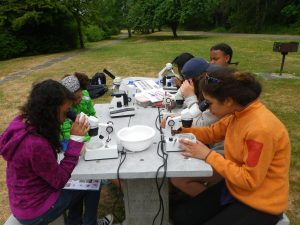
Demonstration experiments are a classic method used in educational settings to help students learn and understand known relationships already discovered by others. Learners will usually have had prior exposure to the relationships through preliminary observations, lectures, reading, and discussions, and will have some sense of what the experimental outcome might be.
Good demonstration experiments actively involve the learner, who manipulates the experimental materials, applies the treatments, and observes the outcomes, then gathers, analyzes, and interprets the resulting data. Poor demonstration experiments, in contrast, make learners only passive witnesses to something done by an expert at the front of the classroom.
In the plant propagation labs for this course, you will be actively engaged in demonstration experiments. Although you won’t be creating new knowledge, the knowledge will likely be new to you. The hands-on experience of conducting the experiments will help you to learn the concepts more effectively than if you only read a textbook or listened to a lecture. The techniques you learn and use in demonstration experiments often contribute to the learning experience as much as the relationships revealed at the experiment’s conclusion. Employing these techniques will help you gain an understanding of many biological functions, such as the production of adventitious roots and mechanisms for seed dispersal.
While demonstration experiments are valuable for actively learning a body of scientific knowledge previously discovered and communicated by others, the experience is specifically orchestrated for teaching and learning, not for the discovery of new information. Yet since the knowledge is new to the learner, it can still bring the joy of personal discovery and a sense of accomplishment.
In summary, demonstration experiments:
- Are designed for teaching and learning.
- Address relationships that may be new to you, but are otherwise known.
- In their best forms, actively involve the learner.
- May emphasize experimental techniques, in addition to outcomes, as part of the learning experience.
- Are not the types of experiments that are at the core of practicing science as a way to uncover new knowledge.
Evaluation experiments
Evaluation experiments are designed to help us make decisions, and to choose from a number of options. They might, for instance, help us determine the efficacy of a new treatment relative to a known treatment, or decide on further experimentation. An evaluation experiment will highlight a compound, a technique, a piece of equipment, or an organism, and will include a control and/or other alternatives.
Evaluation experiments are common in horticultural and agronomic research, where the purpose of the experiment is to identify, for example, the best cultivar , production method, pest control, fertility regime, or light intensity for growing a crop. Correct experimental design is crucial for assuring that conclusions from the experiment are meaningful and credible.
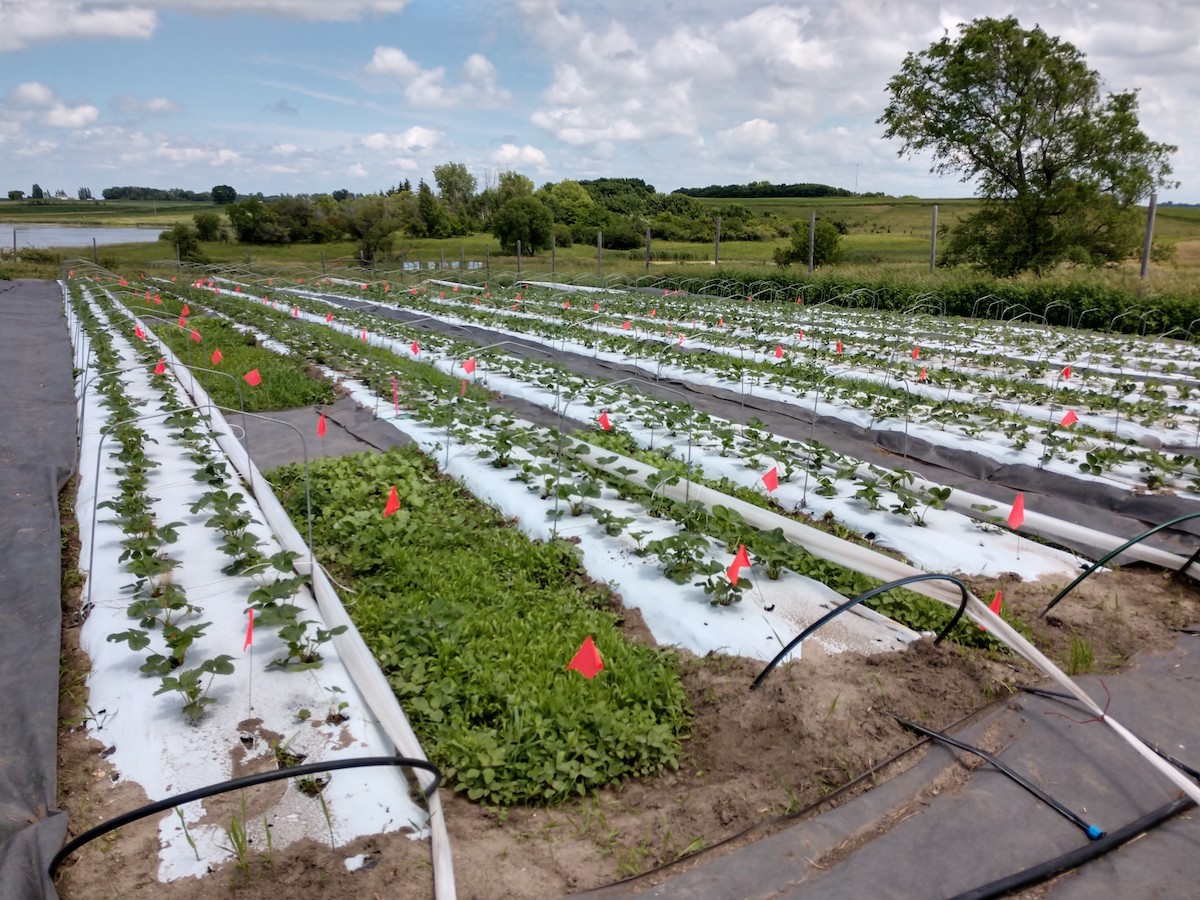
These experiments are typically used in the development of new technologies to identify the best method for the desired purpose (e.g., which pesticides are effective against the target insect, but not harmful to non-target insects). They are not used to discover new knowledge about how the world works, as they typically don’t advance our understanding of the natural world. The information from an evaluation experiment might, however, point the way to additional experimentation that does help us discover new knowledge. This is particularly true if the outcome of an evaluation experiment is unexpected or novel.
In summary, evaluation experiments:
- Are used to help in decision-making.
- Help users choose a winner or determine efficacy relative to other alternatives.
- Are commonly used when evaluating and recommending horticultural production methods.
- Can be useful in solving problems and developing technologies.
- Require proper experimental design (e.g., comparison to a control) for credibility and meaningfulness.
Exploration experiments
Some scientists specialize in observing and cataloging nature, and some aggressively search for previously unknown phenomena. In the botanical realm, such scientists study the diversity of organisms within habitats, discover new species, or are in other ways very skilled in “seeing” nature. Explorer-scientists recognize and appreciate detail and can identify the enormous diversity among plants by comparing characteristics that might be overlooked by others. They may also have the capacity to recognize possible interrelationships among organisms and with habitats, making their work particularly important to science. They might notice, for instance, that a particular species of plant is commonly found in wet areas but not in dry, or that a particular vegetable tastes sweeter when grown at higher altitudes than when grown closer to sea level. They don’t confirm the cause of these relationships, but are the first to notice them.
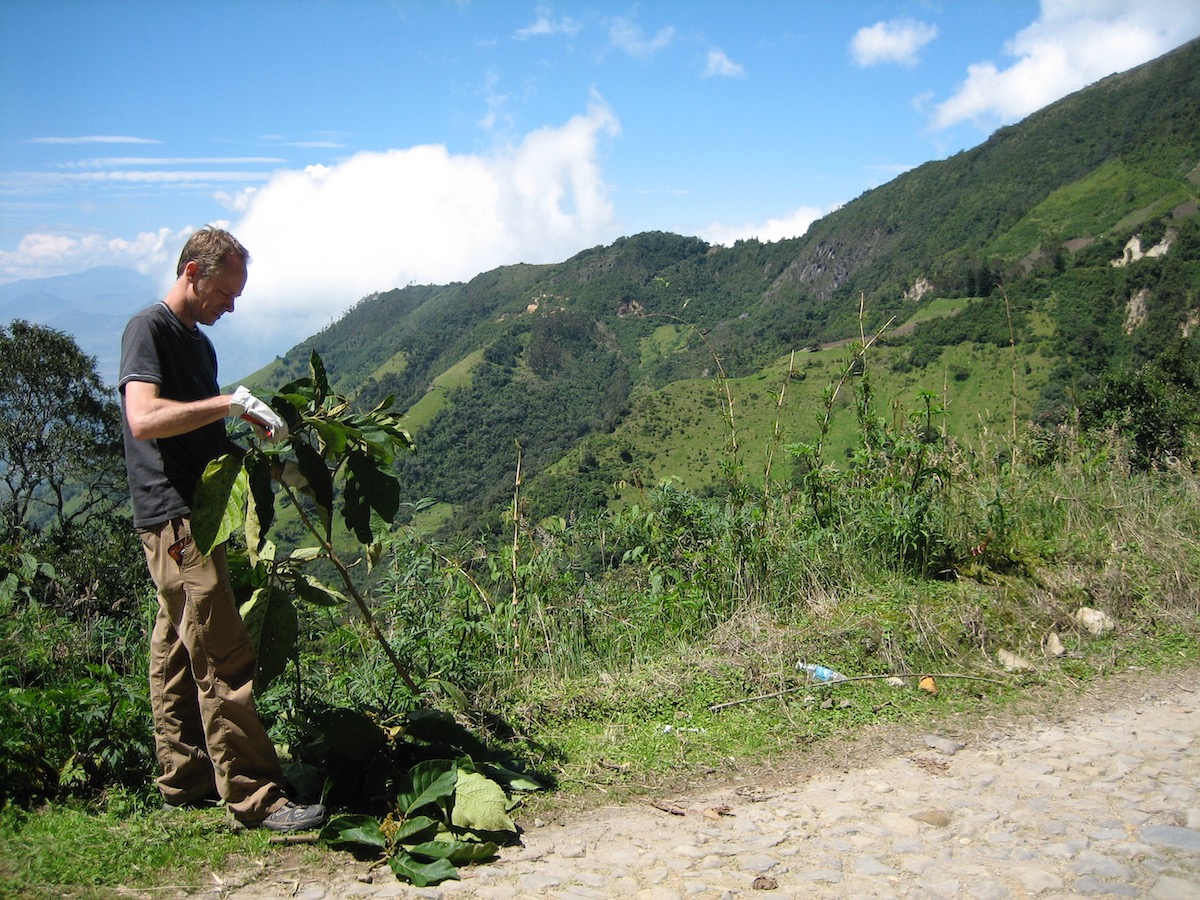
Explorers’ observations are essential to stimulating the development of sound, testable hypotheses. The possible relationships they propose must be tested to determine whether those relationships actually exist, or are artifacts of other effects. Explorers help develop hypotheses, but the work of exploration, cataloging, and seeing possible relationships don’t prove or disprove the hypotheses or necessarily generate new knowledge about relationships. The work does, however, result in new information about the existence of the object or phenomenon itself. An exception is exploration done to test a hypothesis, such as a mission to test the hypothesis that a particular type of ecosystem is required for reproduction of a particular plant species.
Scientists must resist jumping to conclusions based on exploration and observation alone. If you see two people together many times, for example, you might conclude that they are a romantic couple, when in fact they are brother and sister. Relationships hypothesized as a result of exploration and observation must be experimentally tested before they are accepted or rejected.
Exploration experiments uncover new things, many of which can be exciting and eventually change our view of the world. While one of their greatest values is that they lead to the development of new and stronger hypotheses about how the world works, they go so far as to test those hypotheses or fully engage in the cycle of knowledge generation associated with the scientific method. Additional experiments based on this new information are required to put this new information in context and to advance our understanding of how the natural world works.
In summary then, exploration experiments:
- Focus on detailed observation of organisms and habitats.
- Increase our knowledge of the natural world.
- Identify potential relationships that need to be tested.
- Are essential to sound and testable hypothesis-building.
Discovery experiments
Discovery experiments are central to the use of the scientific method in tasks ranging from problem solving to the discovery of new knowledge. They focus on uncovering new relationships and solving problems, follow the scientific method, test hypotheses and their predicted outcomes, and utilize a careful design in order to maintain meaningfulness and credibility.
The similarity between the scientific method and Kolb’s Experiential Learning Cycle is not an accident. The scientific method is a practical strategy based on how we sense and experience the world around us and used to solve problems encountered during those experiences.
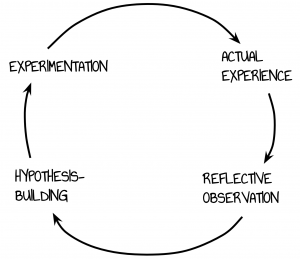
The diagram above illustrates a combination of the scientific method and Kolb’s four-step experiential learning, describing a cyclic process for solving problems that can be applied to disciplines as diverse as molecular biology, global warming, and even appliance repair. While you might initially think that appliance repair doesn’t belong in that list, the difference is one of application, not method. Though far removed from the esoteric scientific discoveries we associate with scientific method, appliance repair follows the same steps. Appliances are often, and quite literally, boxes, where you don’t know what is going on inside. But what’s going on inside is knowable, and through that knowledge comes repair.

The learning/problem solving/scientific process could theoretically start anywhere in Kolb’s cycle. But it will likely start with a problem that needs to be solved, something you don’t understand but would like to know more about. You become aware that there is a problem or that you lack understanding because you have an experience where you observe something and then step back and said, “I wonder how that works,” or perhaps, “why is that broken?” Through observation you develop a sufficiently adequate description of the problem to start doing some research on what is already known.
With a good description of the problem in hand, you can begin to review what is known through the work of others, and think about what might be going on in your situation and how your new understanding can be applied to the problem. This is “reflective observation.” It isn’t just sitting back and thinking in a vacuum. You need raw material for your mind to work on, and that only comes through the tough task of gathering and engaging with the background information. There is a very important quiet phase in this process when you let your mind assemble and sort through ideas until alternatives begin to emerge that might lead to a solution. Talking with others and sharing ideas is an important part of this quiet phase.
Sometimes the alternatives are no- brainers (blown fuse?), and sometimes they’re more creative (residue from the wrong detergent gunking up the water level sensor?). Regardless of their simplicity or complexity, these become hypotheses that need to be tested. The hypothesis-building stage includes both a statement of how something works or why it isn’t working, and predictions about what might happen if the hypothesis is true. In appliance repair, for example, the prediction will likely be that the appliance will function normally. In horticultural molecular biology, it might be that you will see accumulation of a particular type of fatty acid in the cotyledons .
You put the hypothesis to the test by designing an experiment that assesses whether your predictions were right. If the outcome doesn’t match your prediction, you reject the hypothesis (the fuse was ok, so that wasn’t the problem). If the outcome does match your prediction, you tentatively accept the hypothesis pending further observation (when the fuse was replaced the washing machine worked again, so it might have been a blown fuse, but on the other hand maybe it was just because the motor had time to cool down). As with evaluation experimentation, experimental design is important in assuring that the conclusions from the experiment are meaningful and credible.
Experimentation leads to new experiences and an incremental increase in knowledge, and then the cycle begins again.
In summary, discovery experiments:
- Focus on uncovering new relationships and solving problems.
- Follow scientific method.
- Test hypotheses and their predicted outcomes.
- Utilize a careful design in order to maintain meaningfulness and credibility.
Of the four types of experiments, only the discovery experiments are core to the process of science in the narrow sense of being a way of acquiring new knowledge. The other three types of experimentation are still important; demonstration and evaluation experiments are valuable for learning and decision-making and for technology development, and exploration experiments are essential for developing testable hypotheses. But discovery experiments are core to science.
Remember: the methodology of effective washing machine repair, when applied to what is unknown about the physical world, is the methodology of science. It’s not esoteric; it’s good appliance repair.
You might argue that, when applied to a broken washing machine, a discovery experiment results in knowledge that is probably already known by those skilled in appliance repair, so it isn’t really new knowledge about how the world works. That’s a fair criticism. Use of the scientific method can result in new knowledge about how the world works, but whether it uncovers new knowledge depends on the object of experimentation.
Review questions
Experimental design
The methods for designing experiments are carefully studied and often discipline-specific. Methods used in molecular biology, for instance, will be somewhat different from those used in chemistry or in field evaluations of horticultural plants. There are, however, some generalizations we can make about good experimental designs.
Emphasize comparisons
Experiments include more than just one treatment. “Treatment” refers to the factor that you are varying in your experiment—for example, different cultivars of tomato, different fertilizers, or different amounts of light. Experimental designs incorporate comparison of treatments. You usually compare the treatments to one another and often to a control, which is either the application of no treatment or the application of a customary or standard level of treatment.
If you grow a particular type of tomato in your garden, and find that it produces tasty fruit, would you declare it to be the best tomato variety you could grow? Certainly not. You couldn’t even say with certainty that it was the best tomato variety you have ever grown (unless it is the only one you have grown). Next year, however, you could grow that tomato as your control, and grow two other varieties that your neighbors like, and compare fruit quality (appearance, flavor, yield, sugar content). You could then say something definitive about the three tomato varieties because you have compared them to each other after growing them next to each other in the same year and environment.
Replicate treatments
The same treatment is applied to more than one “experimental unit”—the object that receives the treatment. In the example above, the tomato plant is the experimental unit, and you would perhaps plant two or three seedlings of each tomato variety rather than just one. Think of a treatment as something like a fertilizer spread on a patch of land. The patch of land is the experimental unit, while the fertilizer is the treatment.
By applying the treatment to more than one experimental unit you can estimate the variation you get when two experimental units are treated the same, and compare this to the variation when experimental units are given different treatments. If the treatments actually differ in their effectiveness, you would expect the variation between experimental units given different treatments to be much greater than the variation between those given the same treatment. This is one of the fundamental ways in which experiments are statistically analyzed and treatments declared significantly different or not.
Randomize treatments
Once you know how many treatments you are going to apply, and how many replications you want, the product of these two quantities (# treatments × # replications) equals the number of experimental units you need. For instance, if you have three fertilizers you want to test, plus a control, you have four treatments. If you want three replications of each treatment, then you 4 treatments x 3 replications = 12 experimental units or patches of land where you will apply the fertilizers. The treatments will be randomly assigned to each experimental unit (patch of land). This is done using a random number table and is not just haphazard picking. Randomization helps minimize any bias you haven’t recognized in advance and controlled for in other ways.
- What are two types of control treatments?
- Does increasing the number of replications increase the number of treatments or the number of experimental units?
- Can you think of an example of how randomization can protect against bias?
Process of scientific inquiry; it builds on what is known by testing hypotheses.
A very valuable method for actively learning the body of scientific knowledge that has been previously discovered and communicated by others; and it is specifically orchestrated for teaching and learning, not for the discovery of new information about the world around us.
Typically used during the development of new technologies to identify the best products for the desired purpose (eg. which pesticides are effective against the target insect, but not harmful to non-target insects), but are not used to discover new knowledge about how the world works so they typically don't advance our understanding of the natural world. Used to pick a winner from among a number of options.
Used to verify or regulate a scientific experiment by conducting a parallel experiment or by comparing with another standard
A plant variety that has been produced in cultivation by selective breeding. The term comes from combining the words 'cultivated' and 'variety'.
Process of planning an experiment to test a hypothesis.
An embryonic leaf in seed-bearing plants, one or more of which are the first leaves to appear from a germinating seed.
When the same treatment is applied to more than one experimental unit.
Act of randomly assigning treatments to experimental units using a random number table or computer-generated randomization to help minimize any bias that has not been recognized in advance and controlled for in other ways.
The Science of Plants Copyright © 2022 by The Authors is licensed under a Creative Commons Attribution-NonCommercial 4.0 International License , except where otherwise noted.
Share This Book

- Science Notes Posts
- Contact Science Notes
- Todd Helmenstine Biography
- Anne Helmenstine Biography
- Free Printable Periodic Tables (PDF and PNG)
- Periodic Table Wallpapers
- Interactive Periodic Table
- Periodic Table Posters
- Science Experiments for Kids
- How to Grow Crystals
- Chemistry Projects
- Fire and Flames Projects
- Holiday Science
- Chemistry Problems With Answers
- Physics Problems
- Unit Conversion Example Problems
- Chemistry Worksheets
- Biology Worksheets
- Periodic Table Worksheets
- Physical Science Worksheets
- Science Lab Worksheets
- My Amazon Books
What Is a Control Variable? Definition and Examples

A control variable is any factor that is controlled or held constant during an experiment . For this reason, it’s also known as a controlled variable or a constant variable. A single experiment may contain many control variables . Unlike the independent and dependent variables , control variables aren’t a part of the experiment, but they are important because they could affect the outcome. Take a look at the difference between a control variable and control group and see examples of control variables.
Importance of Control Variables
Remember, the independent variable is the one you change, the dependent variable is the one you measure in response to this change, and the control variables are any other factors you control or hold constant so that they can’t influence the experiment. Control variables are important because:
- They make it easier to reproduce the experiment.
- The increase confidence in the outcome of the experiment.
For example, if you conducted an experiment examining the effect of the color of light on plant growth, but you didn’t control temperature, it might affect the outcome. One light source might be hotter than the other, affecting plant growth. This could lead you to incorrectly accept or reject your hypothesis. As another example, say you did control the temperature. If you did not report this temperature in your “methods” section, another researcher might have trouble reproducing your results. What if you conducted your experiment at 15 °C. Would you expect the same results at 5 °C or 35 5 °C? Sometimes the potential effect of a control variable can lead to a new experiment!
Sometimes you think you have controlled everything except the independent variable, but still get strange results. This could be due to what is called a “ confounding variable .” Examples of confounding variables could be humidity, magnetism, and vibration. Sometimes you can identify a confounding variable and turn it into a control variable. Other times, confounding variables cannot be detected or controlled.
Control Variable vs Control Group
A control group is different from a control variable. You expose a control group to all the same conditions as the experimental group, except you change the independent variable in the experimental group. Both the control group and experimental group should have the same control variables.
Control Variable Examples
Anything you can measure or control that is not the independent variable or dependent variable has potential to be a control variable. Examples of common control variables include:
- Duration of the experiment
- Size and composition of containers
- Temperature
- Sample volume
- Experimental technique
- Chemical purity or manufacturer
- Species (in biological experiments)
For example, consider an experiment testing whether a certain supplement affects cattle weight gain. The independent variable is the supplement, while the dependent variable is cattle weight. A typical control group would consist of cattle not given the supplement, while the cattle in the experimental group would receive the supplement. Examples of control variables in this experiment could include the age of the cattle, their breed, whether they are male or female, the amount of supplement, the way the supplement is administered, how often the supplement is administered, the type of feed given to the cattle, the temperature, the water supply, the time of year, and the method used to record weight. There may be other control variables, too. Sometimes you can’t actually control a control variable, but conditions should be the same for both the control and experimental groups. For example, if the cattle are free-range, weather might change from day to day, but both groups have the same experience. When you take data, be sure to record control variables along with the independent and dependent variable.
- Box, George E.P.; Hunter, William G.; Hunter, J. Stuart (1978). Statistics for Experimenters : An Introduction to Design, Data Analysis, and Model Building . New York: Wiley. ISBN 978-0-471-09315-2.
- Giri, Narayan C.; Das, M. N. (1979). Design and Analysis of Experiments . New York, N.Y: Wiley. ISBN 9780852269145.
- Stigler, Stephen M. (November 1992). “A Historical View of Statistical Concepts in Psychology and Educational Research”. American Journal of Education . 101 (1): 60–70. doi: 10.1086/444032
Related Posts
What Is a Control Group?
- Chemical Laws
- Periodic Table
- Projects & Experiments
- Scientific Method
- Biochemistry
- Physical Chemistry
- Medical Chemistry
- Chemistry In Everyday Life
- Famous Chemists
- Activities for Kids
- Abbreviations & Acronyms
- Weather & Climate
- Ph.D., Biomedical Sciences, University of Tennessee at Knoxville
- B.A., Physics and Mathematics, Hastings College
A control group in a scientific experiment is a group separated from the rest of the experiment, where the independent variable being tested cannot influence the results. This isolates the independent variable 's effects on the experiment and can help rule out alternative explanations of the experimental results. Control groups can also be separated into two other types: positive or negative. Positive control groups are groups where the conditions of the experiment are set to guarantee a positive result. A positive control group can show the experiment is functioning properly as planned. Negative control groups are groups where the conditions of the experiment are set to cause a negative outcome. Control groups are not necessary for all scientific experiments. Controls are extremely useful where the experimental conditions are complex and difficult to isolate.
Example of a Negative Control Group
Negative control groups are particularly common in science fair experiments , to teach students how to identify the independent variable. A simple example of a control group can be seen in an experiment in which the researcher tests whether or not a new fertilizer has an effect on plant growth. The negative control group would be the set of plants grown without the fertilizer, but under the exact same conditions as the experimental group. The only difference between the experimental group would be whether or not the fertilizer was used.
There could be several experimental groups, differing in the concentration of fertilizer used, its method of application, etc. The null hypothesis would be that the fertilizer has no effect on plant growth. Then, if a difference is seen in the growth rate of the plants or the height of plants over time, a strong correlation between the fertilizer and growth would be established. Note the fertilizer could have a negative impact on growth rather than a positive impact. Or, for some reason, the plants might not grow at all. The negative control group helps establish that the experimental variable is the cause of atypical growth, rather than some other (possibly unforeseen) variable.
Example of a Positive Control Group
A positive control demonstrates an experiment is capable of producing a positive result. For example, let's say you are examining bacterial susceptibility to a drug. You might use a positive control to make sure the growth medium is capable of supporting any bacteria. You could culture bacteria known to carry the drug resistance marker, so they should be capable of surviving on a drug-treated medium. If these bacteria grow, you have a positive control that shows other drug-resistance bacteria should be capable of surviving the test.
The experiment could also include a negative control. You could plate bacteria known not to carry a drug resistance marker. These bacteria should be unable to grow on the drug-laced medium. If they do grow, you know there is a problem with the experiment.
- Understanding Experimental Groups
- The Difference Between Control Group and Experimental Group
- List of Platinum Group Metals or PGMs
- Scientific Hypothesis, Model, Theory, and Law
- What Is an Experiment? Definition and Design
- What Is a Base Metal? Definition and Examples
- What Chemistry Is and What Chemists Do
- What Is a Molecule?
- Acid Dissociation Constant Definition: Ka
- Fatty Acid Definition
- Dissolving Sugar in Water: Chemical or Physical Change?
- Hydroxyl Group Definition in Chemistry
- Heavy Metals in Science
- Is Glass a Liquid or a Solid?
- Examples of Independent and Dependent Variables
- Noble Metals List and Properties
Sciencing_Icons_Science SCIENCE
Sciencing_icons_biology biology, sciencing_icons_cells cells, sciencing_icons_molecular molecular, sciencing_icons_microorganisms microorganisms, sciencing_icons_genetics genetics, sciencing_icons_human body human body, sciencing_icons_ecology ecology, sciencing_icons_chemistry chemistry, sciencing_icons_atomic & molecular structure atomic & molecular structure, sciencing_icons_bonds bonds, sciencing_icons_reactions reactions, sciencing_icons_stoichiometry stoichiometry, sciencing_icons_solutions solutions, sciencing_icons_acids & bases acids & bases, sciencing_icons_thermodynamics thermodynamics, sciencing_icons_organic chemistry organic chemistry, sciencing_icons_physics physics, sciencing_icons_fundamentals-physics fundamentals, sciencing_icons_electronics electronics, sciencing_icons_waves waves, sciencing_icons_energy energy, sciencing_icons_fluid fluid, sciencing_icons_astronomy astronomy, sciencing_icons_geology geology, sciencing_icons_fundamentals-geology fundamentals, sciencing_icons_minerals & rocks minerals & rocks, sciencing_icons_earth scructure earth structure, sciencing_icons_fossils fossils, sciencing_icons_natural disasters natural disasters, sciencing_icons_nature nature, sciencing_icons_ecosystems ecosystems, sciencing_icons_environment environment, sciencing_icons_insects insects, sciencing_icons_plants & mushrooms plants & mushrooms, sciencing_icons_animals animals, sciencing_icons_math math, sciencing_icons_arithmetic arithmetic, sciencing_icons_addition & subtraction addition & subtraction, sciencing_icons_multiplication & division multiplication & division, sciencing_icons_decimals decimals, sciencing_icons_fractions fractions, sciencing_icons_conversions conversions, sciencing_icons_algebra algebra, sciencing_icons_working with units working with units, sciencing_icons_equations & expressions equations & expressions, sciencing_icons_ratios & proportions ratios & proportions, sciencing_icons_inequalities inequalities, sciencing_icons_exponents & logarithms exponents & logarithms, sciencing_icons_factorization factorization, sciencing_icons_functions functions, sciencing_icons_linear equations linear equations, sciencing_icons_graphs graphs, sciencing_icons_quadratics quadratics, sciencing_icons_polynomials polynomials, sciencing_icons_geometry geometry, sciencing_icons_fundamentals-geometry fundamentals, sciencing_icons_cartesian cartesian, sciencing_icons_circles circles, sciencing_icons_solids solids, sciencing_icons_trigonometry trigonometry, sciencing_icons_probability-statistics probability & statistics, sciencing_icons_mean-median-mode mean/median/mode, sciencing_icons_independent-dependent variables independent/dependent variables, sciencing_icons_deviation deviation, sciencing_icons_correlation correlation, sciencing_icons_sampling sampling, sciencing_icons_distributions distributions, sciencing_icons_probability probability, sciencing_icons_calculus calculus, sciencing_icons_differentiation-integration differentiation/integration, sciencing_icons_application application, sciencing_icons_projects projects, sciencing_icons_news news.
- Share Tweet Email Print
- Home ⋅
- Science ⋅
- Physics ⋅
- Fundamentals
What Are Dependent, Independent & Controlled Variables?
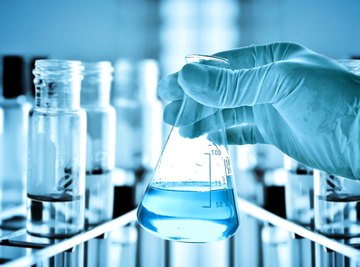
What Is a Responding Variable in Science Projects?
Say you're in lab, and your teacher asks you to design an experiment. The experiment must test how plants grow in response to different colored light. How would you begin? What are you changing? What are you keeping the same? What are you measuring?
These parameters of what you would change and what you would keep the same are called variables. Take a look at how all of these parameters in an experiment are defined, as independent, dependent and controlled variables.
What Is a Variable?
A variable is any quantity that you are able to measure in some way. This could be temperature, height, age, etc. Basically, a variable is anything that contributes to the outcome or result of your experiment in any way.
In an experiment there are multiple kinds of variables: independent, dependent and controlled variables.
What Is an Independent Variable?
An independent variable is the variable the experimenter controls. Basically, it is the component you choose to change in an experiment. This variable is not dependent on any other variables.
For example, in the plant growth experiment, the independent variable is the light color. The light color is not affected by anything. You will choose different light colors like green, red, yellow, etc. You are not measuring the light.
What Is a Dependent Variable?
A dependent variable is the measurement that changes in response to what you changed in the experiment. This variable is dependent on other variables; hence the name! For example, in the plant growth experiment, the dependent variable would be plant growth.
You could measure this by measuring how much the plant grows every two days. You could also measure it by measuring the rate of photosynthesis. Either of these measurements are dependent upon the kind of light you give the plant.
What Are Controlled Variables?
A control variable in science is any other parameter affecting your experiment that you try to keep the same across all conditions.
For example, one control variable in the plant growth experiment could be temperature. You would not want to have one plant growing in green light with a temperature of 20°C while another plant grows in red light with a temperature of 27°C.
You want to measure only the effect of light, not temperature. For this reason you would want to keep the temperature the same across all of your plants. In other words, you would want to control the temperature.
Another example is the amount of water you give the plant. If one plant receives twice the amount of water as another plant, there would be no way for you to know that the reason those plants grew the way they did is due only to the light color their received.
The observed effect could also be due in part to the amount of water they got. A control variable in science experiments is what allows you to compare other things that may be contributing to a result because you have kept other important things the same across all of your subjects.
Graphing Your Experiment
When graphing the results of your experiment, it is important to remember which variable goes on which axis.
The independent variable is graphed on the x-axis . The dependent variable , which changes in response to the independent variable, is graphed on the y-axis . Controlled variables are usually not graphed because they should not change. They could, however, be graphed as a verification that other conditions are not changing.
For example, after graphing the growth as compared to light, you could also look at how the temperature varied across different conditions. If you notice that it did vary quite a bit, you may need to go back and look at your experimental setup: How could you improve the experiment so that all plants are exposed to as similar an environment as possible (aside from the light color)?
How to Remember Which is Which
In order to try and remember which is the dependent variable and which is the independent variable, try putting them into a sentence which uses "causes a change in."
Here's an example. Saying, "light color causes a change in plant growth," is possible. This shows us that the independent variable affects the dependent variable. The inverse, however, is not true. "Plant growth causes a change in light color," is not possible. This way you know which is the independent variable and which is the dependent variable!
Related Articles
What are constants & controls of a science project..., what are independent & dependent variables in science..., difference between manipulative & responding variable, how to collect data from a science project, science fair projects on plants: do they grow faster..., how to write a testable hypothesis, how to grow a plant from a bean as a science project, what is the role of carotenoids in photosynthesis, proper way to label a graph, two week science projects, why should you only test for one variable at a time..., definitions of control, constant, independent and dependent..., what is a constant in a science fair project, science projects on which fertilizer makes a plant..., venus flytrap science projects, the effect of temperature on the rate of photosynthesis, phototropism experiments, cool science project ideas for k-4th grade, measuring wet bulb temperature.
- NCES Kids: What are Independent and Dependent Variables?
- Khan Academy: Dependent and independent variables review (article)
About the Author
Riti Gupta holds a Honors Bachelors degree in Biochemistry from the University of Oregon and a PhD in biology from Johns Hopkins University. She has an interest in astrobiology and manned spaceflight. She has over 10 years of biology research experience in academia. She currently teaches classes in biochemistry, biology, biophysics, astrobiology, as well as high school AP Biology and Chemistry test prep.
Find Your Next Great Science Fair Project! GO

Home » experimental control important
What An Experimental Control Is And Why It’s So Important
Daniel Nelson
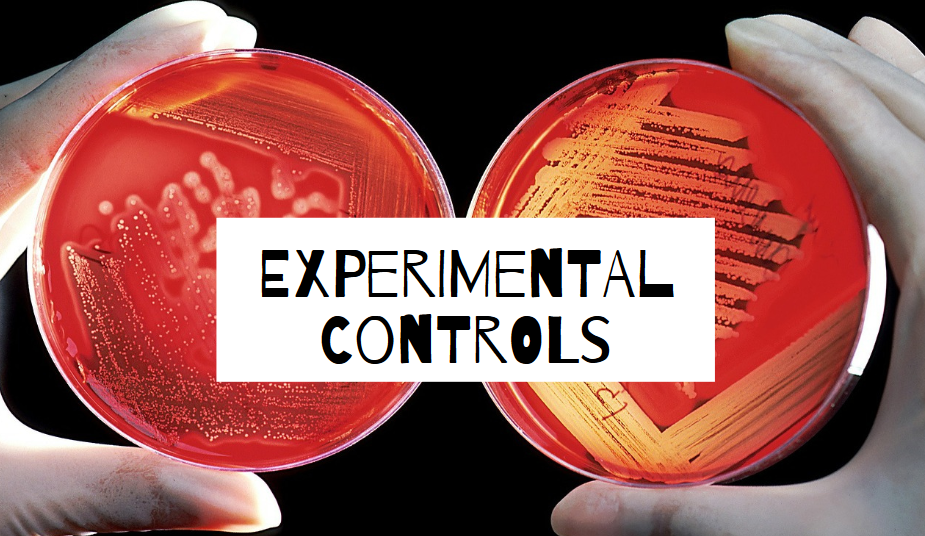
An experimental control is used in scientific experiments to minimize the effect of variables which are not the interest of the study. The control can be an object, population, or any other variable which a scientist would like to “control.”
You may have heard of experimental control, but what is it? Why is an experimental control important? The function of an experimental control is to hold constant the variables that an experimenter isn’t interested in measuring.
This helps scientists ensure that there have been no deviations in the environment of the experiment that could end up influencing the outcome of the experiment, besides the variable they are investigating. Let’s take a closer look at what this means.
You may have ended up here to understand why a control is important in an experiment. A control is important for an experiment because it allows the experiment to minimize the changes in all other variables except the one being tested.
To start with, it is important to define some terminology.
Terminology Of A Scientific Experiment
| Negative | The negative control variable is a variable or group where no response is expected |
| Positive | A positive control is a group or variable that receives a treatment with a known positive result |
| Randomization | A randomized controlled seeks to reduce bias when testing a new treatment |
| Blind experiments | In blind experiments, the variable or group does not know the full amount of information about the trial to not skew results |
| Double-blind experiments | A double-blind group is where all parties do not know which individual is receiving the experimental treatment |
Randomization is important as it allows for more non-biased results in experiments. Random numbers generators are often used both in scientific studies as well as on 지노 사이트 to make outcomes fairer.
Scientists use the scientific method to ask questions and come to conclusions about the nature of the world. After making an observation about some sort of phenomena they would like to investigate, a scientist asks what the cause of that phenomena could be. The scientist creates a hypothesis, a proposed explanation that answers the question they asked. A hypothesis doesn’t need to be correct, it just has to be testable.
The hypothesis is a prediction about what will happen during the experiment, and if the hypothesis is correct then the results of the experiment should align with the scientist’s prediction. If the results of the experiment do not align with the hypothesis, then a good scientist will take this data into consideration and form a new hypothesis that can better explain the phenomenon in question.
Independent and Dependent Variables
In order to form an effective hypothesis and do meaningful research, the researcher must define the experiment’s independent and dependent variables . The independent variable is the variable which the experimenter either manipulates or controls in an experiment to test the effects of this manipulation on the dependent variable. A dependent variable is a variable being measured to see if the manipulation has any effect.
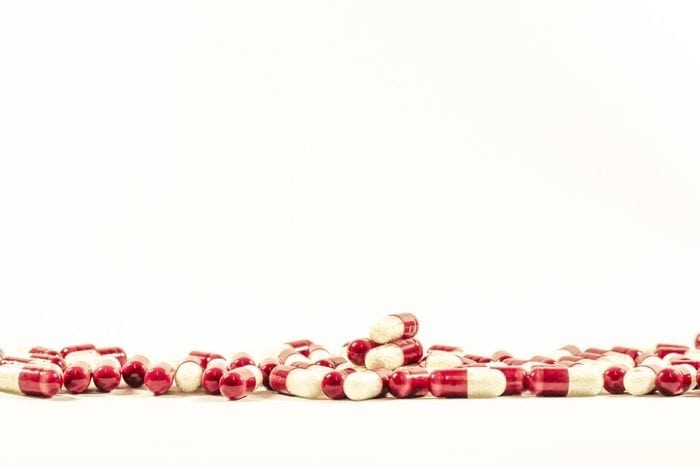
Photo: frolicsomepl via Pixabay, CC0
For instance, if a researcher wanted to see how temperature impacts the behavior of a certain gas, the temperature they adjust would be the independent variable and the behavior of the gas the dependent variable.
Control Groups and Experimental Groups
There will frequently be two groups under observation in an experiment, the experimental group, and the control group . The control group is used to establish a baseline that the behavior of the experimental group can be compared to. If two groups of people were receiving an experimental treatment for a medical condition, one would be given the actual treatment (the experimental group) and one would typically be given a placebo or sugar pill (the control group).
Without an experimental control group, it is difficult to determine the effects of the independent variable on the dependent variable in an experiment. This is because there can always be outside factors that are influencing the behavior of the experimental group. The function of a control group is to act as a point of comparison, by attempting to ensure that the variable under examination (the impact of the medicine) is the thing responsible for creating the results of an experiment. The control group is holding other possible variables constant, such as the act of seeing a doctor and taking a pill, so only the medicine itself is being tested.
Why Are Experimental Controls So Important?
Experimental controls allow scientists to eliminate varying amounts of uncertainty in their experiments. Whenever a researcher does an experiment and wants to ensure that only the variable they are interested in changing is changing, they need to utilize experimental controls.
Experimental controls have been dubbed “controls” precisely because they allow researchers to control the variables they think might have an impact on the results of the study. If a researcher believes that some outside variables could influence the results of their research, they’ll use a control group to try and hold that thing constant and measure any possible influence it has on the results. It is important to note that there may be many different controls for an experiment, and the more complex a phenomenon under investigation is, the more controls it is likely to have.
Not only do controls establish a baseline that the results of an experiment can be compared to, they also allow researchers to correct for possible errors. If something goes wrong in the experiment, a scientist can check on the controls of the experiment to see if the error had to do with the controls. If so, they can correct this next time the experiment is done.
A Practical Example
Let’s take a look at a concrete example of experimental control. If an experimenter wanted to determine how different soil types impacted the germination period of seeds , they could set up four different pots. Each pot would be filled with a different soil type, planted with seeds, then watered and exposed to sunlight. Measurements would be taken regarding how long it took for the seeds to sprout in the different soil types.
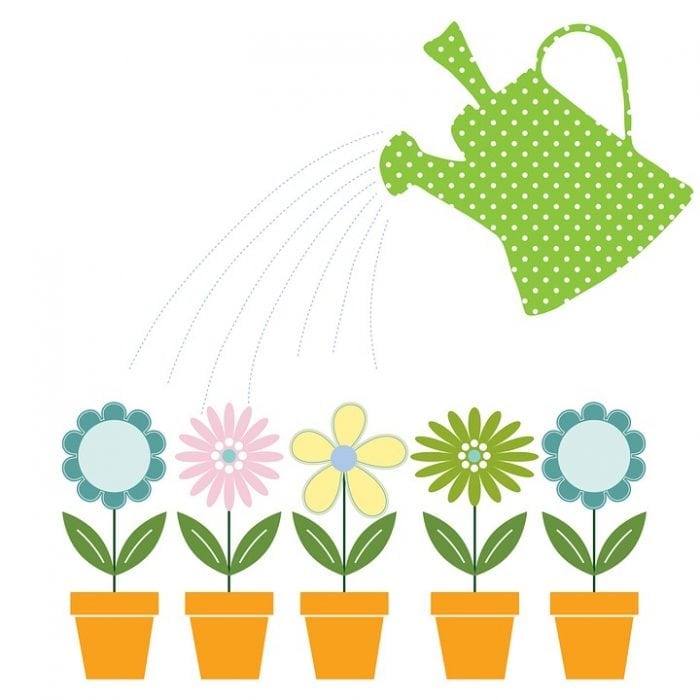
Photo: Kaz via Pixabay, CC0
A control for this experiment might be to fill more pots with just the different types of soil and no seeds or to set aside some seeds in a pot with no soil. The goal is to try and determine that it isn’t something else other than the soil, like the nature of the seeds themselves, the amount of sun they were exposed to, or how much water they are given, that affected how quickly the seeds sprouted. The more variables a researcher controlled for, the surer they could be that it was the type of soil having an impact on the germination period.
Not All Experiments Are Controlled
“It doesn’t matter how beautiful your theory is, it doesn’t matter how smart you are. If it doesn’t agree with experiment, it’s wrong.” — Richard P. Feynman
While experimental controls are important , it is also important to remember that not all experiments are controlled. In the real world, there are going to be limitations on what variables a researcher can control for, and scientists often try to record as much data as they can during an experiment so they can compare factors and variables with one another to see if any variables they didn’t control for might have influenced the outcome. It’s still possible to draw useful data from experiments that don’t have controls, but it is much more difficult to draw meaningful conclusions based on uncontrolled data.
Though it is often impossible in the real world to control for every possible variable, experimental controls are an invaluable part of the scientific process and the more controls an experiment has the better off it is.
← Previous post
Next post →
Have a language expert improve your writing
Run a free plagiarism check in 10 minutes, generate accurate citations for free.
- Knowledge Base
Methodology
- What Is a Controlled Experiment? | Definitions & Examples
What Is a Controlled Experiment? | Definitions & Examples
Published on April 19, 2021 by Pritha Bhandari . Revised on June 22, 2023.
In experiments , researchers manipulate independent variables to test their effects on dependent variables. In a controlled experiment , all variables other than the independent variable are controlled or held constant so they don’t influence the dependent variable.
Controlling variables can involve:
- holding variables at a constant or restricted level (e.g., keeping room temperature fixed).
- measuring variables to statistically control for them in your analyses.
- balancing variables across your experiment through randomization (e.g., using a random order of tasks).
Table of contents
Why does control matter in experiments, methods of control, problems with controlled experiments, other interesting articles, frequently asked questions about controlled experiments.
Control in experiments is critical for internal validity , which allows you to establish a cause-and-effect relationship between variables. Strong validity also helps you avoid research biases , particularly ones related to issues with generalizability (like sampling bias and selection bias .)
- Your independent variable is the color used in advertising.
- Your dependent variable is the price that participants are willing to pay for a standard fast food meal.
Extraneous variables are factors that you’re not interested in studying, but that can still influence the dependent variable. For strong internal validity, you need to remove their effects from your experiment.
- Design and description of the meal,
- Study environment (e.g., temperature or lighting),
- Participant’s frequency of buying fast food,
- Participant’s familiarity with the specific fast food brand,
- Participant’s socioeconomic status.
Here's why students love Scribbr's proofreading services
Discover proofreading & editing
You can control some variables by standardizing your data collection procedures. All participants should be tested in the same environment with identical materials. Only the independent variable (e.g., ad color) should be systematically changed between groups.
Other extraneous variables can be controlled through your sampling procedures . Ideally, you’ll select a sample that’s representative of your target population by using relevant inclusion and exclusion criteria (e.g., including participants from a specific income bracket, and not including participants with color blindness).
By measuring extraneous participant variables (e.g., age or gender) that may affect your experimental results, you can also include them in later analyses.
After gathering your participants, you’ll need to place them into groups to test different independent variable treatments. The types of groups and method of assigning participants to groups will help you implement control in your experiment.
Control groups
Controlled experiments require control groups . Control groups allow you to test a comparable treatment, no treatment, or a fake treatment (e.g., a placebo to control for a placebo effect ), and compare the outcome with your experimental treatment.
You can assess whether it’s your treatment specifically that caused the outcomes, or whether time or any other treatment might have resulted in the same effects.
To test the effect of colors in advertising, each participant is placed in one of two groups:
- A control group that’s presented with red advertisements for a fast food meal.
- An experimental group that’s presented with green advertisements for the same fast food meal.
Random assignment
To avoid systematic differences and selection bias between the participants in your control and treatment groups, you should use random assignment .
This helps ensure that any extraneous participant variables are evenly distributed, allowing for a valid comparison between groups .
Random assignment is a hallmark of a “true experiment”—it differentiates true experiments from quasi-experiments .
Masking (blinding)
Masking in experiments means hiding condition assignment from participants or researchers—or, in a double-blind study , from both. It’s often used in clinical studies that test new treatments or drugs and is critical for avoiding several types of research bias .
Sometimes, researchers may unintentionally encourage participants to behave in ways that support their hypotheses , leading to observer bias . In other cases, cues in the study environment may signal the goal of the experiment to participants and influence their responses. These are called demand characteristics . If participants behave a particular way due to awareness of being observed (called a Hawthorne effect ), your results could be invalidated.
Using masking means that participants don’t know whether they’re in the control group or the experimental group. This helps you control biases from participants or researchers that could influence your study results.
You use an online survey form to present the advertisements to participants, and you leave the room while each participant completes the survey on the computer so that you can’t tell which condition each participant was in.
Although controlled experiments are the strongest way to test causal relationships, they also involve some challenges.
Difficult to control all variables
Especially in research with human participants, it’s impossible to hold all extraneous variables constant, because every individual has different experiences that may influence their perception, attitudes, or behaviors.
But measuring or restricting extraneous variables allows you to limit their influence or statistically control for them in your study.
Risk of low external validity
Controlled experiments have disadvantages when it comes to external validity —the extent to which your results can be generalized to broad populations and settings.
The more controlled your experiment is, the less it resembles real world contexts. That makes it harder to apply your findings outside of a controlled setting.
There’s always a tradeoff between internal and external validity . It’s important to consider your research aims when deciding whether to prioritize control or generalizability in your experiment.
If you want to know more about statistics , methodology , or research bias , make sure to check out some of our other articles with explanations and examples.
- Student’s t -distribution
- Normal distribution
- Null and Alternative Hypotheses
- Chi square tests
- Confidence interval
- Quartiles & Quantiles
- Cluster sampling
- Stratified sampling
- Data cleansing
- Reproducibility vs Replicability
- Peer review
- Prospective cohort study
Research bias
- Implicit bias
- Cognitive bias
- Placebo effect
- Hawthorne effect
- Hindsight bias
- Affect heuristic
- Social desirability bias
In a controlled experiment , all extraneous variables are held constant so that they can’t influence the results. Controlled experiments require:
- A control group that receives a standard treatment, a fake treatment, or no treatment.
- Random assignment of participants to ensure the groups are equivalent.
Depending on your study topic, there are various other methods of controlling variables .
An experimental group, also known as a treatment group, receives the treatment whose effect researchers wish to study, whereas a control group does not. They should be identical in all other ways.
Experimental design means planning a set of procedures to investigate a relationship between variables . To design a controlled experiment, you need:
- A testable hypothesis
- At least one independent variable that can be precisely manipulated
- At least one dependent variable that can be precisely measured
When designing the experiment, you decide:
- How you will manipulate the variable(s)
- How you will control for any potential confounding variables
- How many subjects or samples will be included in the study
- How subjects will be assigned to treatment levels
Experimental design is essential to the internal and external validity of your experiment.
Cite this Scribbr article
If you want to cite this source, you can copy and paste the citation or click the “Cite this Scribbr article” button to automatically add the citation to our free Citation Generator.
Bhandari, P. (2023, June 22). What Is a Controlled Experiment? | Definitions & Examples. Scribbr. Retrieved August 23, 2024, from https://www.scribbr.com/methodology/controlled-experiment/
Is this article helpful?

Pritha Bhandari
Other students also liked, extraneous variables | examples, types & controls, guide to experimental design | overview, steps, & examples, how to write a lab report, get unlimited documents corrected.
✔ Free APA citation check included ✔ Unlimited document corrections ✔ Specialized in correcting academic texts
Controlled Experiment
Saul McLeod, PhD
Editor-in-Chief for Simply Psychology
BSc (Hons) Psychology, MRes, PhD, University of Manchester
Saul McLeod, PhD., is a qualified psychology teacher with over 18 years of experience in further and higher education. He has been published in peer-reviewed journals, including the Journal of Clinical Psychology.
Learn about our Editorial Process
Olivia Guy-Evans, MSc
Associate Editor for Simply Psychology
BSc (Hons) Psychology, MSc Psychology of Education
Olivia Guy-Evans is a writer and associate editor for Simply Psychology. She has previously worked in healthcare and educational sectors.
This is when a hypothesis is scientifically tested.
In a controlled experiment, an independent variable (the cause) is systematically manipulated, and the dependent variable (the effect) is measured; any extraneous variables are controlled.
The researcher can operationalize (i.e., define) the studied variables so they can be objectively measured. The quantitative data can be analyzed to see if there is a difference between the experimental and control groups.
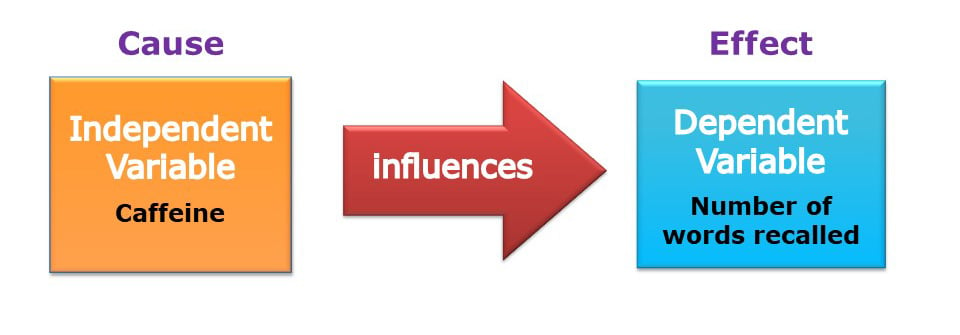
What is the control group?
In experiments scientists compare a control group and an experimental group that are identical in all respects, except for one difference – experimental manipulation.
Unlike the experimental group, the control group is not exposed to the independent variable under investigation and so provides a baseline against which any changes in the experimental group can be compared.
Since experimental manipulation is the only difference between the experimental and control groups, we can be sure that any differences between the two are due to experimental manipulation rather than chance.
Randomly allocating participants to independent variable groups means that all participants should have an equal chance of participating in each condition.
The principle of random allocation is to avoid bias in how the experiment is carried out and limit the effects of participant variables.
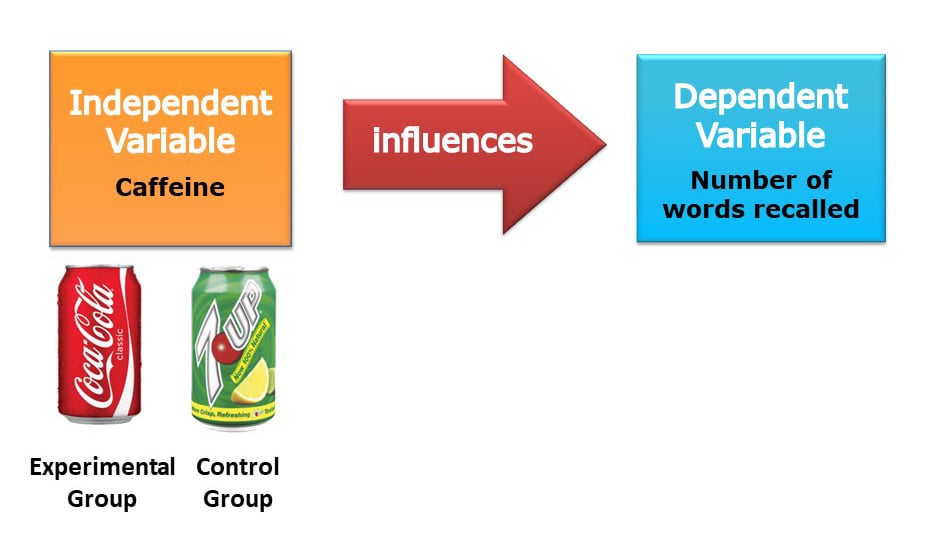
What are extraneous variables?
The researcher wants to ensure that the manipulation of the independent variable has changed the changes in the dependent variable.
Hence, all the other variables that could affect the dependent variable to change must be controlled. These other variables are called extraneous or confounding variables.
Extraneous variables should be controlled were possible, as they might be important enough to provide alternative explanations for the effects.
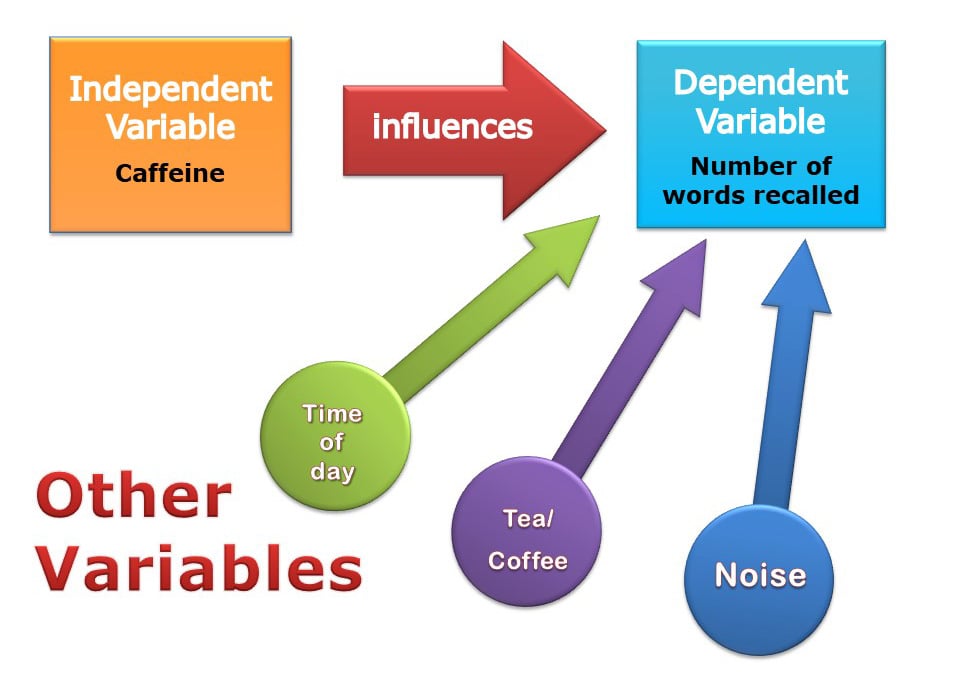
In practice, it would be difficult to control all the variables in a child’s educational achievement. For example, it would be difficult to control variables that have happened in the past.
A researcher can only control the current environment of participants, such as time of day and noise levels.
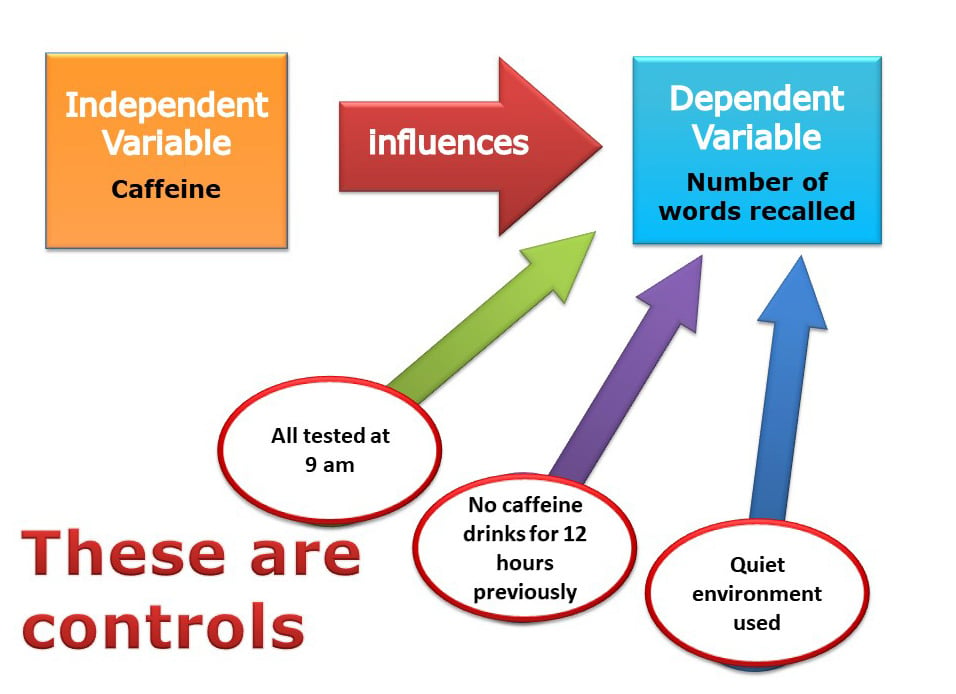
Why conduct controlled experiments?
Scientists use controlled experiments because they allow for precise control of extraneous and independent variables. This allows a cause-and-effect relationship to be established.
Controlled experiments also follow a standardized step-by-step procedure. This makes it easy for another researcher to replicate the study.
Key Terminology
Experimental group.
The group being treated or otherwise manipulated for the sake of the experiment.
Control Group
They receive no treatment and are used as a comparison group.
Ecological validity
The degree to which an investigation represents real-life experiences.
Experimenter effects
These are the ways that the experimenter can accidentally influence the participant through their appearance or behavior.
Demand characteristics
The clues in an experiment lead the participants to think they know what the researcher is looking for (e.g., the experimenter’s body language).
Independent variable (IV)
The variable the experimenter manipulates (i.e., changes) – is assumed to have a direct effect on the dependent variable.
Dependent variable (DV)
Variable the experimenter measures. This is the outcome (i.e., the result) of a study.
Extraneous variables (EV)
All variables that are not independent variables but could affect the results (DV) of the experiment. Extraneous variables should be controlled where possible.
Confounding variables
Variable(s) that have affected the results (DV), apart from the IV. A confounding variable could be an extraneous variable that has not been controlled.
Random Allocation
Randomly allocating participants to independent variable conditions means that all participants should have an equal chance of participating in each condition.
Order effects
Changes in participants’ performance due to their repeating the same or similar test more than once. Examples of order effects include:
(i) practice effect: an improvement in performance on a task due to repetition, for example, because of familiarity with the task;
(ii) fatigue effect: a decrease in performance of a task due to repetition, for example, because of boredom or tiredness.
What is the control in an experiment?
In an experiment , the control is a standard or baseline group not exposed to the experimental treatment or manipulation. It serves as a comparison group to the experimental group, which does receive the treatment or manipulation.
The control group helps to account for other variables that might influence the outcome, allowing researchers to attribute differences in results more confidently to the experimental treatment.
Establishing a cause-and-effect relationship between the manipulated variable (independent variable) and the outcome (dependent variable) is critical in establishing a cause-and-effect relationship between the manipulated variable.
What is the purpose of controlling the environment when testing a hypothesis?
Controlling the environment when testing a hypothesis aims to eliminate or minimize the influence of extraneous variables. These variables other than the independent variable might affect the dependent variable, potentially confounding the results.
By controlling the environment, researchers can ensure that any observed changes in the dependent variable are likely due to the manipulation of the independent variable, not other factors.
This enhances the experiment’s validity, allowing for more accurate conclusions about cause-and-effect relationships.
It also improves the experiment’s replicability, meaning other researchers can repeat the experiment under the same conditions to verify the results.
Why are hypotheses important to controlled experiments?
Hypotheses are crucial to controlled experiments because they provide a clear focus and direction for the research. A hypothesis is a testable prediction about the relationship between variables.
It guides the design of the experiment, including what variables to manipulate (independent variables) and what outcomes to measure (dependent variables).
The experiment is then conducted to test the validity of the hypothesis. If the results align with the hypothesis, they provide evidence supporting it.
The hypothesis may be revised or rejected if the results do not align. Thus, hypotheses are central to the scientific method, driving the iterative inquiry, experimentation, and knowledge advancement process.

What is the experimental method?
The experimental method is a systematic approach in scientific research where an independent variable is manipulated to observe its effect on a dependent variable, under controlled conditions.

An official website of the United States government
Here's how you know
Official websites use .gov A .gov website belongs to an official government organization in the United States.
Secure .gov websites use HTTPS A lock ( Lock Locked padlock ) or https:// means you’ve safely connected to the .gov website. Share sensitive information only on official, secure websites.

Plant Growth and Osmotic Potential
Water is a critical element for plant growth. All water used by land plants is absorbed from the soil by roots through osmosis. Osmosis is the movement of a solvent (e.g.water) across a semipermeable membrane from low solute (e.g.salt) concentration towards higher solute concentration. Excess levels of salts in soils makes soil water solute concentrations higher than in the plant root cells. This can limit plant water uptake, making it harder for plants to grow. (See Appendix A for more information)
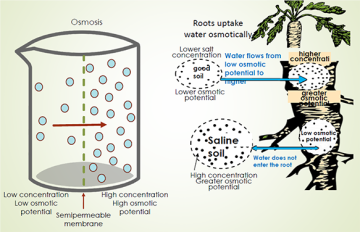
About the Experiment
For this experiment, we’re going to test the effect that high salt soil concentrations have on plant growth and root development.
|
| |
What You'll Need
- 7 clear plastic cups (Solo cups)
- 7 non-clear plastic cups
- Potting soil (small bag)
- Wheatgrass or cat grass seed (250 seeds, can be found online or at local pet store)
- Baking soda
- Measuring spoons
- Drill & small bit

When using table salt (sodium chloride) and baking soda (sodium bicarbonate) to create saline and alkali soils, you can observe the germination and growth of grass leaves at increasing levels of salt and ph. Then you can treat the salt/alkali effected soils with "leaching" and observe plant growth.
Let's Do This!
1 . Drill 3 small holes in 7 clear plastic cups. Have an adult help with this step for safety.

2 . Fill 1 clear cup (with holes) with soil 1” from top of cup and place cup inside non-clear cup (without holes).
Pour ½ cup of water into the soil cup and allow to absorb. Pour another ½ cup of water into the soil cup.
Place 30 grass seeds on top of the wetted soil and cover with 1/8” of new soil and gently wet. Make sure seeds are covered with soil (Label cup “Control”).
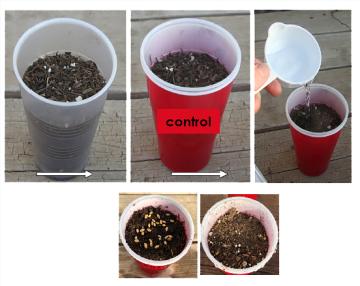
3 . Fill 3 clear cups (with holes) with soil 1” from top. Add 1 teaspoon of salt to the soil of 1 cup (label cup “salt 1”). Add 1 tablespoon of salt to the 2nd cup (label cup “salt 2”). Add 3 tablespoons of salt to the 3rd cup (label cup “salt 3”).
Place each cup in a non-clear cup (no holes) and add ½ cup of water to each and let absorb. Add another ½ cup of water.
Place 30 grass seeds in each cup and cover with 1/8” of new soil and moisten new soil. Make sure seeds are covered with soil (Image 2).
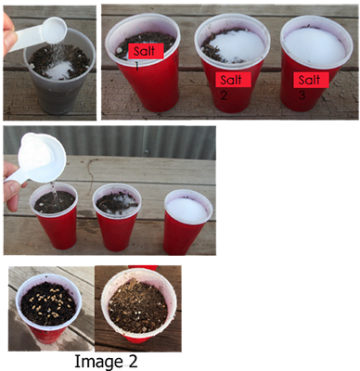
4 . Fill 3 clear cups (with holes) ¼ full with soil. Add 1 tablespoon of baking soda to 1st cup and add more soil to fill cup 1” from the top. Hold your hand over the cup so soil does not spill and shake the cup to mix the baking soda with the soil (label cup “alkali 1”).
Add 2 tablespoons of baking soda to the 2nd cup and fill with soil 1" from top. Again, with hand over cup, shake to mix baking soda and soil (label cup “alkali 2”).
Add ½ cup of baking soda to the 3rd cup, fill with soil 1" from top and shake to mix (label cup “alkali 3”).
Place each cup in a non-clear cup (no holes). Add ½ cup of water to each and let absorb, then add another ½ cup of water. Place 30 grass seeds in each cup and cover with 1/8" of new soil and moisten new soil. Make sure seeds are covered with soil.

5 . Let grass germinate and grow for 1 week.
Let’s Look At The Results!
After 1 week count the number of plants in each cup and measure the tallest blades of grass in each cup. Record the numbers for each on the data sheet . Remove the clear cups and observe root growth.
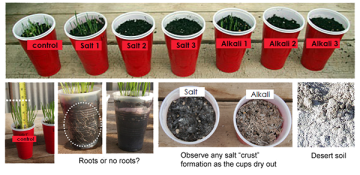
After 1 week, remove “salt 2” and “alkali 2” clear cups from red cups and place in the sink or outside (where water can drain) and slowly pour 6 cups of water through each, making sure to not over-fill (pour ½ cup at a time and let drain).
Observe which cups drains fastest (alkali soils have poor drainage). Make sure seeds are still covered with soil (add some on top if necessary) and let them grow for 1 more week.
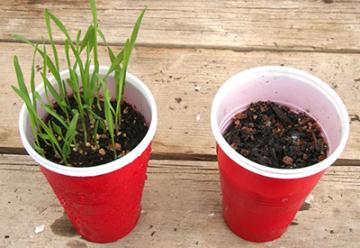
After 1 week (2 weeks total) observe if “leached” cups now have plants that are growing. Did leaching help the same for saline vs. alkali soils?
After 2 weeks , measure the height of plants in each cup and record the results. Again, observe the roots and record observations on the data sheet.
Summarize your data and observations.
- Why did plants grow or not grow in each cup?
- What effect did leaching have on plant growth and why?
- Did leaching work on both salt and baking soda equally and why?
What Is A Controlled Experiment? Aren’t All Experiments Controlled?
Why should you experiment, how should you experiment, key parameters of a controlled experiment, is there such a thing as an uncontrolled experiment.
A procedure that helps you understand the influence of various factors that affect a result and the extent of their effect in a controlled environment.
Have you ever done science experiments that have numerous parameters you need to take care of to get an accurate result?
If so, I know exactly how that feels!
Most of the time, you won’t get a perfect value, but rather a value that is nearly correct. It can be so frustrating at times, as you need to take care of the amount of catalyst, the temperature, pressure and a million other things!
I wonder who found out that you need precisely ‘this’ thing in exactly ‘this’ amount to get ‘that’ thing! Well, over time, I’ve realized just how much important these parameters are. These values help us set up a controlled environment where the experiment can occur.
And while many people loathe doing lengthy experiments, scientists have performed these exact same experiments a million times to find the perfect mix of parameters that give a predictable result! Now that’s perseverance!!

Recommended Video for you:
There was a time when scientists speculated about plants being alive in the same way as humans. Jagdish Chandra Bose was the scientist who was able to prove that plants are indeed living things by noting their response to different stimuli. He used an experiment wherein the roots of a plant’s stem were dipped in a solution of Bromine Chloride, a poison . He observed the pulse of the plant as a white spot on the crescograph, a device that could magnify the motion of plant tissues up to 10,000 times.
This experiment may have been groundbreaking at that time, but his result was derived because of the three steps that every scientist follows to arrive at a conclusion.
- Scientists observe a certain phenomenon that interests them or sparks their curiosity.
- They form a hypothesis, i.e., they try to establish a ‘cause-effect’ relationship for the phenomenon. There are multiple hypotheses for a single occurrence that may or may not be correct.
Example: the atomic model was proposed by many scientists before the most recent Quantum model was accepted. Simply put, a hypothesis is the possible cause of the effect that one wishes to study.
- Now, the hypothesis is often based on mathematical calculations or general observations, but until they are disproved, the theory is not accepted.
- This is where experiments come into the picture. Various experiments are done that can support the hypothesis. If a particular theory is supported by experimental backing, the hypothesis becomes a “scientific theory/discovery”.
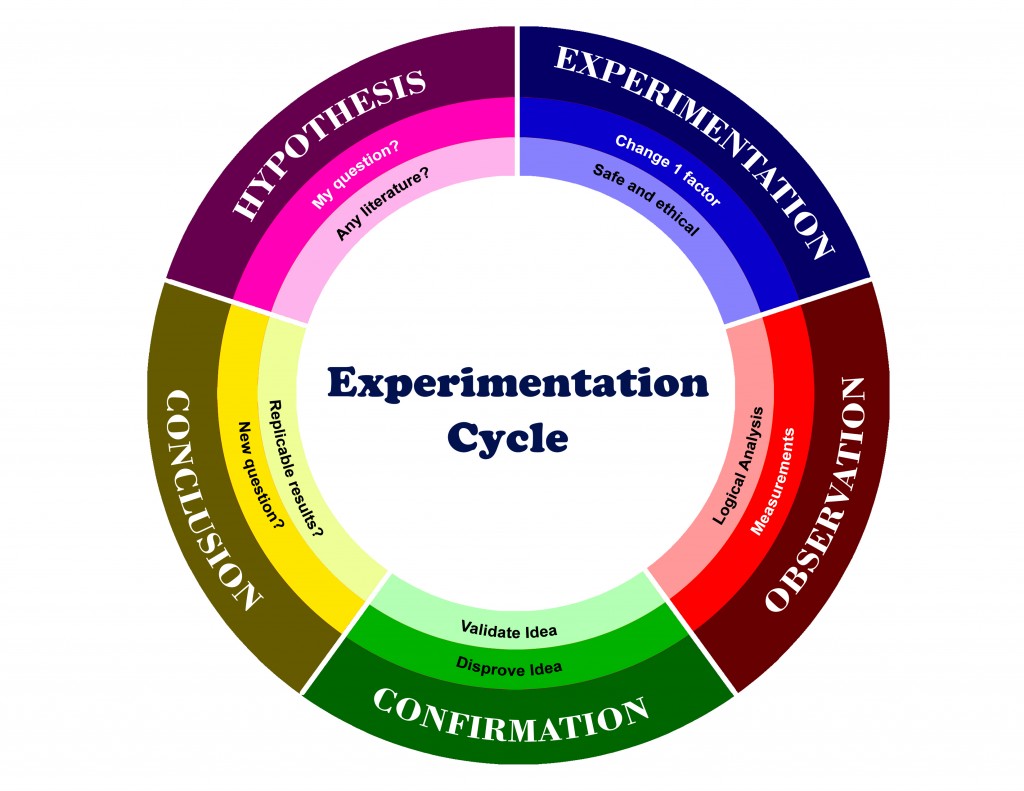
Also Read: What Is Endogeneity? What Is An Exogenous Variable?
To reach effective results, you need to test your hypothesis by performing an experiment, but it’s not as if any random experiment can give you results. A controlled experiment allows you to isolate and study the clear result that will eventually allow you to draw conclusions.
A single phenomenon is the result of multiple factors, but how do you know the independent effect of each factor? A controlled experiment basically limits the scope of the result because only one or two factors affecting the result are allowed to vary. All the other factors are kept constant.
Also Read: What Is An Independent Variable?
Now, when you perform an experiment, you’re basically looking for two things
- The factors that affect the final result.
- The extent to which each factor contributes to the result.
We can identify the elements that affect the result by keeping all the other elements constant. These variables/factors that are constant are known as control variables/constant variables .
If we want to test the effect of a certain (factor) fertilizer on plants, we take two plants, both identical in all respects, such that all the other factors affecting its growth remain constant. Now, to one plant we add the fertilizer, and to the other, we add no fertilizer. Thus, after the allotted time period, if the fertilizer was actually useful, you will see that the growth in one plant is greater than the other. Here, the plant that got the fertilizer is the experimental group and the one without the fertilizer is the control group .
If you’re wondering what the use of the control group is, it basically provides you with a minimal value to start with. It allows you to compare the effect of the fertilizer with respect to the normal growth factor and the extent to which the fertilizer enhanced the growth of the plant. A controlled experiment tries to form a link between the cause and the effect. If we are to study the effect of fertilizers on plant growth, the cause will be the ‘fertilizer’ and its effect would be the ‘growth of the plant’. In other words:
- The fertilizer would be the independent variable — a variable that is changed and modified to study its effect.
- The growth of the plant will be the dependent variable— a variable that is being tested and whose value depends on the independent variable.

Well, after reading all of this, it’s pretty obvious that controlled experiments are often set up that way and don’t occur naturally. They also give results that are reliable and spot on!
Clearly, experiments that don’t have any control variables are uncontrolled in every way. In fact, the entire natural phenomenon that gave rise to a scientist’s hypothesis is an uncontrolled experiment. This implies that, without control, you can still get results, but those results are unclear. You can draw conclusions from uncontrolled experiments, but it’s a lot harder to determine the true influence of individual factors when all of them are acting at the same time.
Some experiments, however, are impossible to control! Experiments that require testing on humans are influenced by genetic makeup, metabolism and psychology, among other factors, all of which are beyond human control. Thus, there is often a result that is simply averaged and used because no particular result can reflect the whole effect.
Uncontrolled experiments may not give perfect results, but they often help scientists observe patterns. A task that was performed better by more females than males helps to identify that there is possibly an element of female psychology, a hormone or temperament that influenced the result.
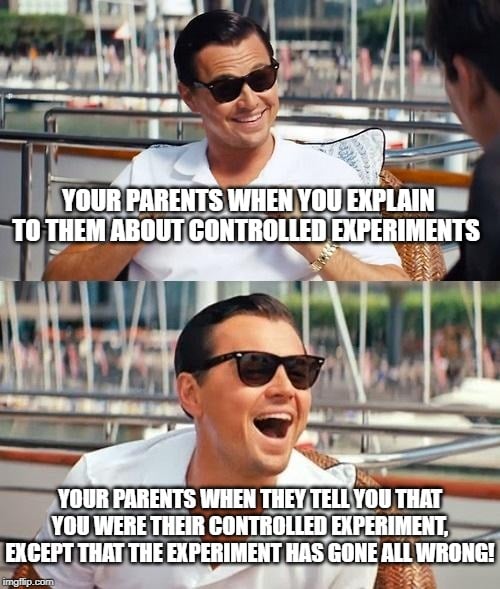
Controlled experimentation is the most widely preferred method used to study and prove a hypothesis. Nature is an intelligent experimenter and designs phenomena that are intricate and detailed, and we humans are still trying to understand those details, so we need to break things into parts before we can understand the whole picture. This is where controlled experimentation helps us. All in all, controlled experimentation aids us in understanding things at a pace we are comfortable with, while giving us time to explore the depths to which we want to study a given occurrence.
- Controlled experiments (article) | Khan Academy. Khan Academy
- How Acharya Jagadish Chandra Bose proved plants have .... India Today
- What are Independent and Dependent Variables?-NCES Kids .... The National Center for Education Statistics
Zankhana has completed her Bachelors in Electronics and Telecommunications Engineering. She is an avid reader of works of mythology and history. She is trained in Hindustani Classical Singing and Kathak. She likes to travel and trusts her artsy heart and scientific mind to take her to places that she has dreamt of.
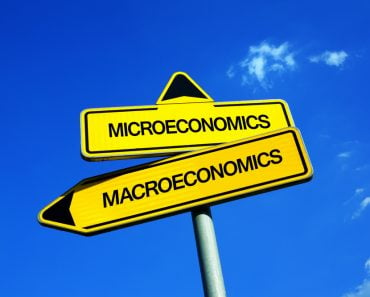
Is Economics A Science?
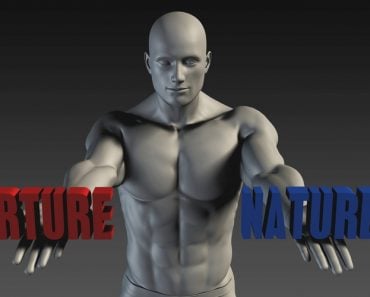
Are We Born With A Fixed Personality Or Can It Be Manipulated By Our Environment?
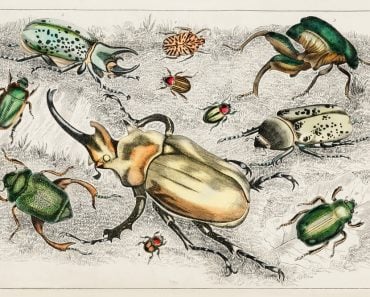
Does (Natural) History Repeat Itself?

What Is Homeostasis?
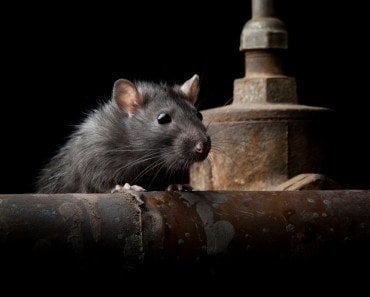
Why Are Rats The Most Preferred Animals For Experiments?

Are We Genetically Predetermined To Like What We Like?
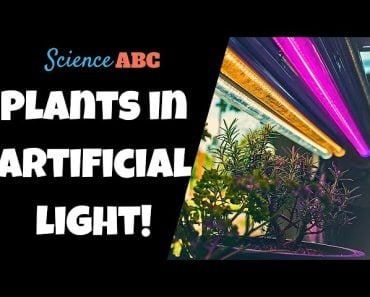
This Is What Happens When You Try To Grow A Plant In Artificial Light
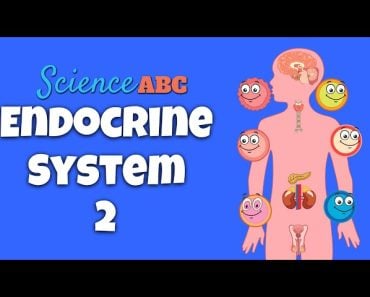
Endocrine System: Glands and Hormones

Germination: How Does A Seed Become A Plant?
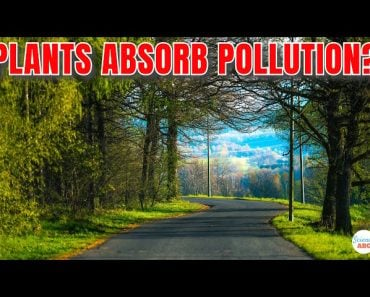
Do Plants Next To Roads ABSORB Pollution And Become HARMFUL?

Photosynthesis: The Biochemistry Behind How Plants Make Their Food

Max Pain: How Much Pain Can A Person Take?
share this!
August 23, 2024
This article has been reviewed according to Science X's editorial process and policies . Editors have highlighted the following attributes while ensuring the content's credibility:
fact-checked
peer-reviewed publication
trusted source
Innovative field experiments shed light on biological clocks in nature
by John Innes Centre
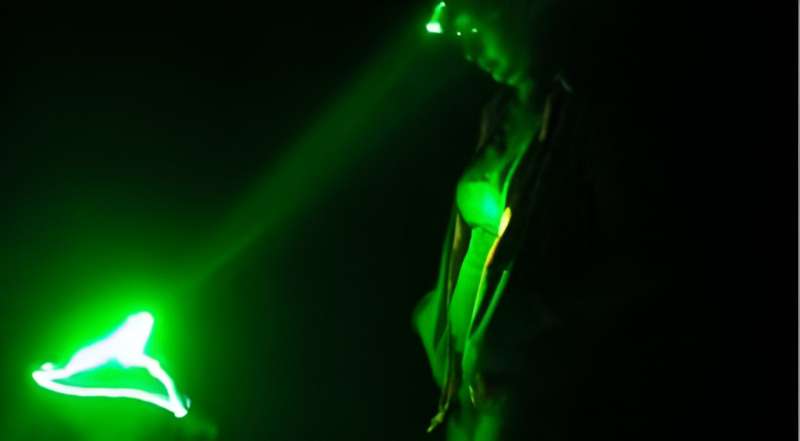
Much of what we know about plant circadian rhythms is the result of laboratory experiments where inputs such as light and temperature can be tightly controlled.
Less is known about how these biological timing mechanisms operate in the more unpredictable natural world where they evolved to align living things to daily and seasonal cycles.
A pioneering collaborative study between UK and Japanese researchers has helped redress the balance with a series of innovative field experiments that show how plants combine clock signals with environmental cues under naturally fluctuating conditions.
This research team from the John Innes Center, Kyoto University, and The Sainsbury Laboratory, Cambridge, have produced statistical models based on these field-based studies that could help us predict how plants, major crops among them, might respond to future temperatures.
"Our research highlights the value of international collaboration in cross-disciplinary scientific progress," said senior author Professor Antony Dodd, a group leader at the John Innes Center. "It is fascinating to see how processes we have identified in the lab also work to influence plants under natural conditions."
Professor Hiroshi Kudoh from Kyoto University said, "Any living system has evolved in the context of its natural habitat. A great deal of work lies ahead to assess the function of genetic systems under natural conditions. This study was designed as one of the beginnings of such an endeavor."
A previous study by the group of Professor Dodd identified a genetic pathway under the control of the biological clock that operates to protect photosynthesizing plants from cell damage in bright cold conditions.
In this present study, "Circadian and environmental signal integration in a natural population of Arabidopsis," which appears in PNAS , the research team set out to identify this same mechanism in nature, drawing on a strong body of "in natura" research led by Professor Hiroshi Kudoh.
In two field studies around the March and September equinoxes, they analyzed a natural population of Arabidopsis halleri plants on a rural Japanese field site.
They monitored how gene expression in the plants changed over 24-hour cycles as light and temperature varied.
Experiments involved extracting RNA from plants every two hours, freezing these samples and taking them back to the lab for analysis so that they could track gene expression levels in tissues.
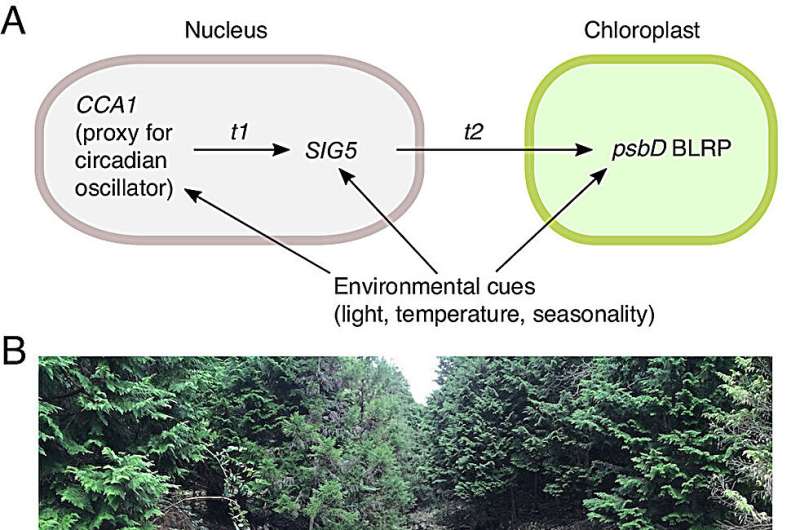
The team also built equipment that enabled them to manipulate the temperatures around plants. This enabled them to recapitulate the conditions they produced in the lab in their previous study.
Plants are highly sensitive to red and blue light; so, to avoid influencing experimental findings, researchers wore green filters over their head torches which effectively meant that they were invisible to plants during nocturnal visits.
"It is surprising how difficult it is to identify green plants with a green head torch in the middle of the night, in pouring rain," remarked Professor Dodd.
Using the information collected from samples, the researchers observed patterns in the expression of genes in the previously discovered genetic pathway that integrates information from the plant circadian clock with light and temperature signals.
The data collected showed that the plants in wild populations showed the same sensitivity to cold and bright dawn conditions previously observed in laboratory experiments.
Based on this information, the team developed statistical models which accurately predict how gene expression activity under control of the circadian clock will respond to environmental signals over a day in nature.
"We believe this is the first time anyone has modeled a whole circadian clock signaling pathway in plants growing outdoors," said Professor Dodd.
"If we can produce models that can accurately predict gene expression in relation to environmental conditions, then it may be possible to breed plants that are able to adapt to future climate conditions."
Dr. Haruki Nishio from Shiga University, joint first author on the study, said, "The flexibility of Bayesian time-series modeling allowed us to disentangle complex signal integration in natural environments. This approach has proven particularly effective for studies conducted in intricate environmental settings."
This study examined plant responses at the level of gene expression. The next stage for this research is to apply the statistical models produced in this study to functions of plant physiology such as the rate of photosynthesis or adaptation to temperature.
Dr. Dora Cano-Ramirez, a circadian clock researcher now at the Sainsbury Laboratory Cambridge University and joint first author of the research, said, "The circadian clock regulates many key plant processes as shown in studies under laboratory settings. However, we have not known the extent to which these processes translate to field conditions until now."
"Understanding how circadian-regulated processes are aligned with a fluctuating environment by modeling this signaling pathway, could be useful in predicting plant responses in an increasingly unpredictable climate."
Journal information: Proceedings of the National Academy of Sciences
Provided by John Innes Centre
Explore further
Feedback to editors

Saturday Citations: Tarantulas and their homies; how mosquitoes find you; black holes not mysterious at all
4 hours ago

Test of a prototype quantum internet runs under New York City for half a month
5 hours ago

Researchers discover dual epicenters in New Year's Day Noto earthquake
19 hours ago

Carbon emissions from forest soil will likely grow with rising temperatures
20 hours ago

Unconventional interface superconductor could benefit quantum computing
22 hours ago

Coaxing purple bacteria into becoming bioplastic factories
23 hours ago

NASA's DART impact permanently changed the shape and orbit of asteroid moon, new study shows

New varactor enhances quantum dot device measurements at millikelvin temperatures
Aug 23, 2024

Aoudad and bighorn sheep share respiratory pathogens, research team discovers

Ecosystems study finds the higher the environmental stress, the lower the resistance to global change
Relevant physicsforums posts, homo naledi: 5 yr update & new findings (2021).
Aug 21, 2024
Hiking Illness Danger -- Rhabdomyolysis
Aug 18, 2024
Toxic Chemicals Found on old books
Strategies and tips for first responders interacting with autism spectrum disorder patients.
Aug 16, 2024
Cannot find a comfortable side-sleeping position
Using capsaicin to get really high.
More from Biology and Medical
Related Stories

How plants cope with the cold light of day, and why it matters for future crops
Mar 30, 2023

How plants become good neighbors in times of stress
Jun 29, 2021

Researchers discover optimum twilight time for plant growth
Aug 6, 2024

Altering the circadian clock adapts barley to short growing seasons
Feb 23, 2024

Plants can tell the time using sugars
Aug 2, 2018

Small protein that synchronizes the circadian clocks in shoots and roots
Apr 13, 2020
Recommended for you

Micro- and nanoplastics ingested by Drosophila cause changes in heart size and function

Single nucleosomes tracked in live cells during cell division using super-resolution microscopy

New approach for profiling complex dynamics at the single-molecule level

Research unravels dual role of membrane protein in rice ethylene signal transduction

Scientists discover novel receptor recognition mechanism for alphavirus
Let us know if there is a problem with our content.
Use this form if you have come across a typo, inaccuracy or would like to send an edit request for the content on this page. For general inquiries, please use our contact form . For general feedback, use the public comments section below (please adhere to guidelines ).
Please select the most appropriate category to facilitate processing of your request
Thank you for taking time to provide your feedback to the editors.
Your feedback is important to us. However, we do not guarantee individual replies due to the high volume of messages.
E-mail the story
Your email address is used only to let the recipient know who sent the email. Neither your address nor the recipient's address will be used for any other purpose. The information you enter will appear in your e-mail message and is not retained by Phys.org in any form.
Newsletter sign up
Get weekly and/or daily updates delivered to your inbox. You can unsubscribe at any time and we'll never share your details to third parties.
More information Privacy policy
Donate and enjoy an ad-free experience
We keep our content available to everyone. Consider supporting Science X's mission by getting a premium account.
E-mail newsletter
- Search Please fill out this field.
- Manage Your Subscription
- Give a Gift Subscription
- Newsletters
- Sweepstakes
- House Plants
How to Get Rid of Gnats for Good
Give these pesky bugs the boot.
- Gnats Overview
- Infestation Causes
- Natural Remedies
- Chemical Treatments
- Preventative Measures
Getty Images
If you have a gnat problem, you may have noticed them swarming around your house plants, hanging out by your fruit bowl, or congregating by your trash can . They're a common problem, so you're definitely not alone. Not only are they unsightly, they can also do damage to your plants if you don't eradicate them quickly.
Fungus gnats are the most common type found around house plants. While fungus gnats do not bite people, fungus gnats and other flying insects can attack your plants and ultimately lead to their demise. Read on to learn how to get rid of gnats, with tips from the experts on how to banish and prevent gnat infestations.
- Jennifer Schutter is a certified Master Gardener and editor of Plantcarefully .
- Tony O’Neill is a gardening expert and founder of Simplify Gardening .
How to Identify Gnats
Flying insects are often lumped into the term "gnats," but in reality, there are different kinds likely bugging your home. Fruit flies like to hang out near old and/or decaying fruit, as their name implies. Drain flies are the ones that you'll occasionally see buzzing around your sink, and they live off of any organic matter buildup in the drain. “There are different types of gnats, but the ones you’re going to be seeing buzzing around your plants are fungus gnats, which feed on decaying plants, like those leaves that are turning yellow or brown or getting crinkly,” says Jennifer Schutter of Plantcarefully.
While adult fungus gnats are more of a nuisance than a danger to plants, their larvae can stunt plant growth and damage plant roots. Larvae, which are early-stage gnats in maggot form, feed on organic matter and chew on plant roots. These larvae often flourish in the soil of potted plants. Large numbers of gnat larvae can significantly damage young plants and seedlings. Though the methods below focus on fungus gnats, or the type that prefer plants, they can generally be used to combat any type of flying insect.
Gnats are small winged insects no larger than a quarter inch long. They can be black, yellow, brown, or tan. Their wings are wide and flat, and they have legs that are longer than their bodies.
Causes of Gnat Infestations
Gnat infestations occur when several gnats reproduce, which they do quickly. “Often, the first sign of a gnat infestation is the sight of small, dark flying insects hovering around the soil of your houseplants ,” says Tony O’Neill of Simplify Gardening. “They are particularly active when you water the plant.”
Other signs of a gnat infestation are your plants wilting, losing leaves, and turning yellow. Slow plant growth can be another sign of a gnat problem. Gnat infestations can weaken your plants and make them more susceptible to other pests and diseases. Some common things that attract fungus gnats include:
- Decaying organic matter, such as compost piles and manure
- Overwatered plants
- Dirty dishes in the sink
- Trash cans that are not emptied regularly
- Fruit bowls that are not covered
“Unfortunately, simply having plants can be enough since they’re tasty snacks for gnats,” Schutter says. “Indoors, they can squeeze through small cracks or holes in your home, around windows, doors, walls, etc. They can also enter through clogged drains and lay eggs in trash cans and soil.”
Wet soil can be particularly alluring for gnats, which breed in wet conditions. “Overwatering is a prime culprit,” O’Neill says. “When the soil remains consistently moist, it creates an ideal breeding ground for fungus gnats. They’re also attracted to decaying plant matter, so overgrown or dead foliage can contribute.”
Natural Remedies to Get Rid of Gnats
You can employ several natural ways to eliminate gnats from your house plants. Since gnats reproduce quickly, you may need to try a few methods to get rid of them all. Natural methods are the best first line of defense, so try these before turning to chemical solutions.
Allow Soil to Dry Out
First, let your soil dry out completely between waterings. This will cut down on the moisture-rich breeding grounds that gnats love. You can invest in a soil moisture monitor to accurately measure the amount of water in your soil, which will help prevent overwatering.
Get Rid of Decaying Matter
Clear your plants and soil of decaying leaves, flowers, or organic matter. Remove dead flowers, leaves, or other plant parts from your plants. You should also check any fruits that are out for overripeness; gnats are attracted to ripe fruits or ones that have begun to ferment. If you usually keep all of your fruit out, consider moving the ones that can be refrigerated into the fridge to prevent attracting gnats.
To kill gnat larvae, try a mixture of soapy water and spray it on your plants’ soil, O’Neill advises. Use one tablespoon of liquid soap (such as dish soap) with one quart of water and spray onto the soil to remove gnat larvae.
Make a Gnat Trap
“Gnats spend most of their lives as larvae and pupae in organic matter like soil, so it makes more sense to target them in this stage than try to get rid of adults, which don’t live long anyway,” Schutter says. One way to get rid of gnat larvae is to make your own gnat trap with a mix of vinegar, dish soap, and sugar. Mix a few tablespoons of apple cider vinegar, a few drops of dish soap, and a sprinkle of sugar. Place the traps in small dishes near where gnats congregate. The gnats will be attracted to the sugar and vinegar and will get trapped by the dish soap and drown, Schutter says.
Try Raw Potato Chunks
“Another little-known gnat hack is putting raw potato chunks into the soil to attract larvae,” Schutter says. “This has the twofold benefit of drawing them away from your plant’s roots and blocking their access simultaneously. It’s worked wonders for me in the past and keeps things super cost-effective.” Keep the potato chunks in the pots for a few days, then toss them and put new ones in until you don’t see any more signs of an infestation, Schutter advises.
Use Yellow Sticky Traps
Sticky traps are a simple and cost-effective way to get rid of adult gnats. Gnats are attracted to the color yellow, and the traps entice them, where they get stuck to the adhesive. Schutter recommends cutting the sticky traps into squares and taping them to sticks (chopsticks, pencils, skewers, etc.). “Pop the sticks into problem pots, and you’ll see adult gnats start to get trapped almost immediately,” she says.
Repot Your Plants
If your plant soil is infested with gnat larvae and you’re having trouble getting rid of them, repot your plants . Use clean containers and fresh potting soil. Repotting plants can also be an effective way to avoid using insecticides. Just remember that if it doesn't work 100 percent, the gnats may come back.
Chemical Treatments to Eliminate Gnats
Experts recommend trying natural remedies first to remove gnats from your house plants. Natural remedies are eco-friendly and pose no health risks to humans or pets. However, it may be time to turn to chemical options if you try a few natural solutions and still have a gnat problem.
Use Hydrogen Peroxide
Hydrogen peroxide is a useful tool to kill gnat larvae and is a common household item. “You can use 20% hydrogen peroxide (preferably 3%) mixed with 80% water to kill gnat larvae immediately,” Schutter says. “Slowly drench the soil until the mixture comes out of the drainage holes.”
Use Bacillus Thuringiensis Israelensis (Bti)
“While I lean towards natural remedies, products containing Bti can be used to target gnat larvae without harming plants,” O’Neill says. Bti is a naturally occurring bacterium found in soils. Bti kills fungus gnat larvae. Follow the instructions on your product, adding Bti to the soil of your plants. This will kill gnat larvae while leaving your plants unharmed.
Try Aerosol Sprays
Use an insecticide spray that kills gnats. Aerosol sprays with pyrethrins are very effective at killing adult gnats, Schutter says. To effectively use aerosol insecticides, spray them directly on the gnats from about a foot and a half away. Also, treat any areas where you've seen gnats congregating so they won't return. Just be mindful that insecticides can be harmful to people and pets, so make sure not to get too close to food, utensils, or areas your furry friends like to lay in.
Hire a Professional
If you’ve exhausted your options and still have a gnat infestation, it’s time to call in the pros. Hire a professional pest control company for help. Professional pest companies bring expertise that can save you time and money. They can identify where nests are and ensure safe methods to eradicate them. Often, these pest control companies can access chemicals you can't simply buy in the store that are more effective and efficient at eliminating gnats.
Preventative Measures to Keep Gnats Away
You can take some simple steps to prevent gnat infestations from attacking your house plants in the first place. Keeping your home clean and free of excess water and decaying matter will help ward off gnats. Take these precautions to prevent gnats:
- Avoid overwatering your plants.
- Inspect your plants often and prune off or throw out dead leaves and flowers.
- Use a fine layer of sand or diatomaceous earth on top of plant soil to deter gnats from laying eggs.
- Use well-draining pots and soils.
- Inspect new plants for gnats before buying them.
- Seal cracks and holes around doorways, windows, and drains to prevent gnats from entering.
- Clean up damp places and allow them to dry.
- Use tightly sealed garbage and compost bins and take the trash out daily.
- Do not let dishes and water pile up in the sink.
- Refrigerate fruits and vegetables as much as possible.
- Keep drains clean so there's no organic matter to attract gnats.
Frequently Asked Questions
If you're seeing a lot of gnats in your home, the most likely cause is that something is attracting them. Gnats will only stay where they have food; any produce left out will attract them. Garbage is another gnat magnet, so make sure yours is emptied regularly and covered, if possible. Clean out your drains, as gnats can live off of any organic matter that's collected in them.
The best smells for getting rid of gnats are vinegar, peppermint, vanilla, pine, eucalyptus, lavender, and pine. If you have essential oils, putting a few drops on a cotton ball near where gnats tend to congregate should drive them away. Don't have essential oils? Try dryer sheets instead! Most dryer sheets have scents that gnats don't like.
Adult gnats live from seven to 10 days on average, but the length of their life is dependent on the species. While the entire lifecycle of a gnat (from hatching to death) is around 30 days, the adult phase where they're flying around is much shorter. Fruit flies can live as long as 50 days, where fungus gnats generally only stay around for around a week.
Related Articles

Site Search
- About ARPA-E
- Team Directory
- ARPA-E History
- Annual Reports
- Budget Requests
- Apply For Funding
- Authorization
- View Active Programs
- Search Our Programs
- Search Individual Projects
- Interactive Project Map
- Exploratory Topics
- The SCALEUP Program
- OPEN Programs
- ARPA-E Technology-to-Market
- Technology Commercialization
- External Engagement Model
- Investor Updates
- ARPA-E News & Media
- Press Releases
- ARPA-E Disruptors
- Publications
- ARPA-E Events
- Energy Innovation Summit
- Careers at ARPA-E
- Job Opportunities
- Life at ARPA-E
- Pre-Award Guidance
- Post-Award Guidance
- ARPA-E FAQs
- General Questions
- Current Funding Opportunities
- Closed Funding Opportunities
2024 ARPA-E Fusion Programs Annual Meeting
June 11-12, 2024, seattle, wa, day 1: tuesday, june 11, 2024.
| Time | Event |
| 8:00 - 9:00 AM | Registration & Networking Breakfast |
| 9:00 - 9:10 AM | Ahmed Diallo, Program Director, ARPA-E |
| 9:10 - 9:20 AM | Derek Passarelli, Principal Deputy Under Secretary for Science & Innovation, DOE |
| 9:20 - 9:30 AM | Colleen Nehl, Program Manager, DOE Fusion Energy Sciences |
| 9:30 - 10:20 AM | Performer Technical Highlights: Heating Systems and Drivers |
| 10:20 - 10:45 AM | Break |
| 10:45 - 11:05 AM | Developing The Sheared-Flow-Stabilized Z Pinch As A Fusion Device |
| 11:05 - 11:45 AM | Performer Technical Highlights: DT Fuel Cycle |
| 11:45 - 12:45 PM | Lunch |
| 12:45 - 1:05 PM | Pacific Fusion: Goals and Plans |
| 1:05 - 1:20 PM | Fusion T2M Overview |
| 1:20 - 1:35 PM | The Fusion Industry Supply Chain: Opportunities And Challenges |
| 1:35 - 2:05 PM | Performer Technical Highlights: Modeling And Simulation |
| 2:05 - 2:35 PM | Break |
| 2:35 - 2:55 PM | Double the Fusion Power With Spin-Polarized Fuel |
| 2:55 - 3:00 PM | CATF Fusion Program Highlights |
| 3:00 - 4:00 PM | Panel Discussion: Attracting DOD Interest for Fusion Energy Research |
| 4:00 - 6:00 PM | Location: Compass Room |
| 6:00 PM | Adjourn Day 1 |
Day 2: Wednesday June 12, 2024
| Time | Event |
| 8:00 – 9:00 AM | Registration & Networking Breakfast |
| 9:00 – 9:10 AM | Day 2 Opening Remarks
|
| 9:10 – 9:40 AM |
David Kirtley, CEO, Helion Energy |
| 9:40 – 10:30 AM | Performer Technical Highlights: Fusion Materials |
| 10:30 – 10:50 AM | Break |
| 10:50 – 11:00 AM |
Chris Ajemian, Principal, Chris Ajemian Consulting |
| 11:00 – 11:10 AM | ITER: Collaborating with Private Sector Fusion Start-Ups (Recorded Remarks) |
| 11:10 – 12:00 PM | Performer Technical Highlights: Novel Fusion Concepts |
| 12:00 PM – 2:00 PM | BETHE, GAMOW, OPEN 2021 and CREATE Fusion Programs + Industry and Early Career |
| 2:00 - 2:20 PM | Hiroshi Gota, VP of Program Management, TAE Technologies |
| 2:20 - 2:40 PM | Randy Curry, DMTS, Sandia National Laboratories |
| 2:40 - 2:50 PM | Adelaide Giantelli, Chief, State Agreements and Liaison Program Branch, Office of Nuclear Material Safety and Safeguards, NRC |
| 2:50 - 3:00 PM | Ahmed Diallo, Program Director, ARPA-E |
| 3:00 PM | Adjourn Day 2 |
Performer Information
| Program | Project Title | Principal Investigator | Prime Recipient |
| BETHE | A Simulation Resource Team for Innovative Fusion Concepts | Adam Sefkow | University of Rochester |
| BETHE | An HTS axisymmetric magnetic mirror on a faster path to lower cost fusion energy | Cary Forest | University of Wisconsin |
| BETHE | Centrifugal Mirror Fusion Experiment | Carlos Romero-Talamas | University of Maryland |
| BETHE | Data-enabled Fusion Technology | Craig Michoski | Sapientai LLC |
| BETHE | Target Formation and Integrated Experiments for Plasma-Jet Driven Magneto-Inertial Fusion | Feng Chu | Los Alamos National Laboratory |
| BETHE | The Argon Fluoride laser as an enabler for low-cost inertial fusion energy | Matthew Wolford | US Naval Research Laboratory |
| GAMOW | Advance Castable Nanostructured Alloys for First-Wall/Blanket Applications | Ying Yang | Oak Ridge National Laboratory |
| GAMOW | EM-ENHANCED HyPOR LOOP FOR FAST FUSION FUEL CYCLES | George Larsen | Savannah River National Laboratory |
| GAMOW | ENHANCED Shield: A Critical Materials Technology Enabling Compact Superconducting Tokamaks | Lance Snead | Stony Brook University |
| GAMOW | Fusion Energy Reactor Models Integrator (FERMI) | Vittorio Badalassi | Oak Ridge National Laboratory |
| GAMOW | High Efficiency, Megawatt Class Gyrotrons for Instability Control of Burning Plasma Machines | Jagadishwar Sirigiri | Bridge 12 Technologies, Inc. |
| GAMOW | Interfacial-Engineered Membranes for Efficient Tritium Extraction | Colin Wolden | Colorado School of Mines |
| GAMOW | Plasma Facing Component Innovations by Advanced Manufacturing and Design | Yutai Katoh | Oak Ridge National Laboratory |
| GAMOW | AMPERE - Advanced Materials for Plasma-Exposed Robust Electrodes | Richard Wirz | Oregon State University |
| OPEN 2021 | Advanced Manufacturing of High-Entropy Alloys as Cost-Effective Plasma Facing Components for Fusion Power Generation | Osman El Atwani | Pacific Northwest National Laboratory |
| OPEN 2021 | Economical Proton-Boron11 Fusion | Nathaniel Fisch | Princeton University |
| OPEN 2021 | Liquid Immersion Blanket: Robust Accountancy (LIBRA) | Kevin Woller | Massachusetts Institute of Technology |
| OPEN 2021 | Longer Wavelength Lasers for Inertial Fusion Energy with Laser-Plasma Instability Control: Machine Learning Optimum Spike Trains of Uneven Duration and Delay (STUD Pulses) | Bedros Afeyan | Polymath Research, Inc. |
| CREATE | Active-target muon source for muon-catalyzed fusion | Ara Knaian | NK Labs, LLC |
| CREATE | Advanced Metal Foil Pumps and Integrated Test Environment for the Fusion Fuel Cycle | Adam Rutkowski | Marathon Fusion |
| CREATE | Highly Efficient Charged Particle Beam Injection into Magnetically Confined Plasmas | Christopher Tully | Princeton University |
| ET | Laser Driver for Inertial Fusion Energy | Mike Perry | General Atomics |
Industry and Early Career Poster Information
| Organization | Presenter | Type |
| Avalanche Energy | Mike Prato | Industry |
| Lunar Resources | Elliot Carol | Industry |
| OpenStar Technologies | Thomas Berry | Industry |
| Proxima Fusion | Francesco Sciortino | Industry |
| University of Alabama - Huntsville | Andrew Walsten | Early Career |
August 20, 2024
I Bought a Glowing Plant. It Led Me Down a Rabbit Hole
A bioluminescent petunia led me to a world of radiant mushrooms, 19th century experiments and a modern rivalry between scientists in Russia and the Americas
By Rachel Ehrenberg & Knowable Magazine
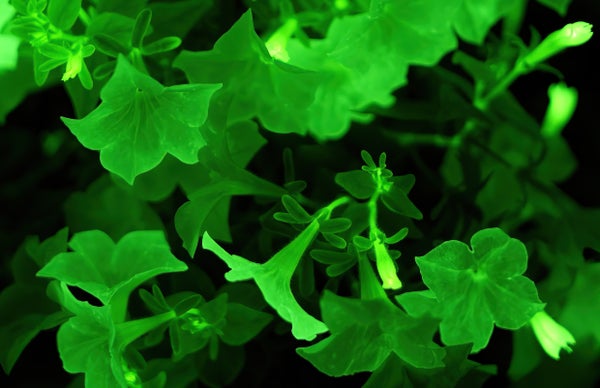
Firefly petunias ( detail ) engineered to glow continuously by the biotech start-up Light Bio.
Light Bio, Inc.
Petunias have never done much for me. If you had told me that one day, I’d fork over more than $50 for a single petunia plant, my eyes would have rolled out of my head. But this plant was special. This petunia glowed in the dark.
My plant was one of 50,000 shipped around the United States in April by the Idaho-based biotech start-up Light Bio . Called the “Firefly” petunia, it contains genes from bioluminescent mushrooms that make it constantly glow. A news release announcing the petunia’s arrival included a photo of a woman gazing serenely at a mass of flowers lit up like oversized glow-in-the-dark stars.
Well, that’s a neat trick, I thought.
On supporting science journalism
If you're enjoying this article, consider supporting our award-winning journalism by subscribing . By purchasing a subscription you are helping to ensure the future of impactful stories about the discoveries and ideas shaping our world today.
I also wondered whether the Firefly petunia was more than just a trick. Though it seemed inconsequential, perhaps there was some implication I hadn’t thought of. At the very least, the plant might make me — a great admirer of plants (but a bit of a botanical snob) — think differently about petunias, those go-to ornamentals for gas stations and mansions alike.
I decided to learn more. So I paid my $53 ($29 for the plant, $24 for shipping) and placed an order.
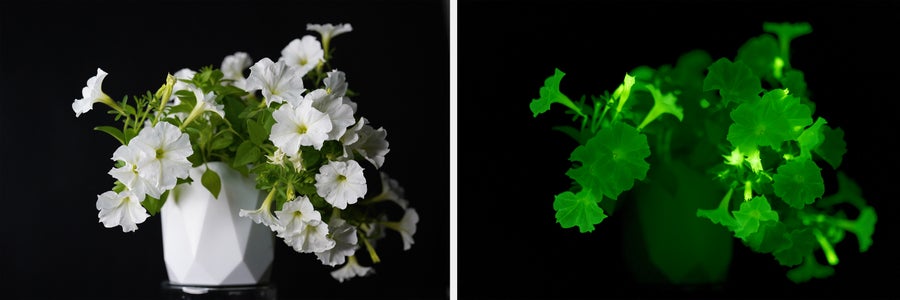
The Firefly petunia’s flower buds seem to give off the most light, as seen with the specimen shown in both daylight and in the dark.
Light Bio. Inc.
Behold, bioluminescence
Bioluminescence is the emission of light by living things. It is generated by a chemical reaction within the organism (unlike the phosphorescence of glow-in-the-dark stickers, which need to be charged up with light before emitting it). Bioluminescence is widespread, especially in the oceans : There are bacteria, sea snails, shrimp, fish and squid that glow. Terrestrial glowers include some insects and worms as well as fungi.
Scientists have worked out the precise chemical compounds involved for only a handful of bioluminescent organisms. But for the most part, the basics of the light-producing reaction are the same: It requires fuel, oxygen and a catalyst to get the reaction going. In the parlance of bioluminescence research, the fuel is called the luciferin and the catalyst is called the luciferase. The luciferase helps to add oxygen to the fuel, transforming it into a very reactive, high-energy compound. As this overexcited luciferin relaxes, it emits light.
This ability to produce light has been documented in hundreds of genera across the tree of life. Scientists think it evolved independently in various lineages , perhaps more than 94 different times.
Organisms use bioluminescence in a variety of ways. For fireflies, it’s a come-hither signal that attracts mates. Some fish use it to lure prey. Other animals, such as the vampire squid, which can expel a cloud of glowing mucus, use it to distract or confuse predators. In many lineages, giving off light may have arisen as a detoxification strategy . When oxygen is in a reactive state, it can ricochet through cells and damage molecules. This suggests that many luciferins were antioxidants first; their primary role was to mop up damaging oxygen that had been generated during metabolism.
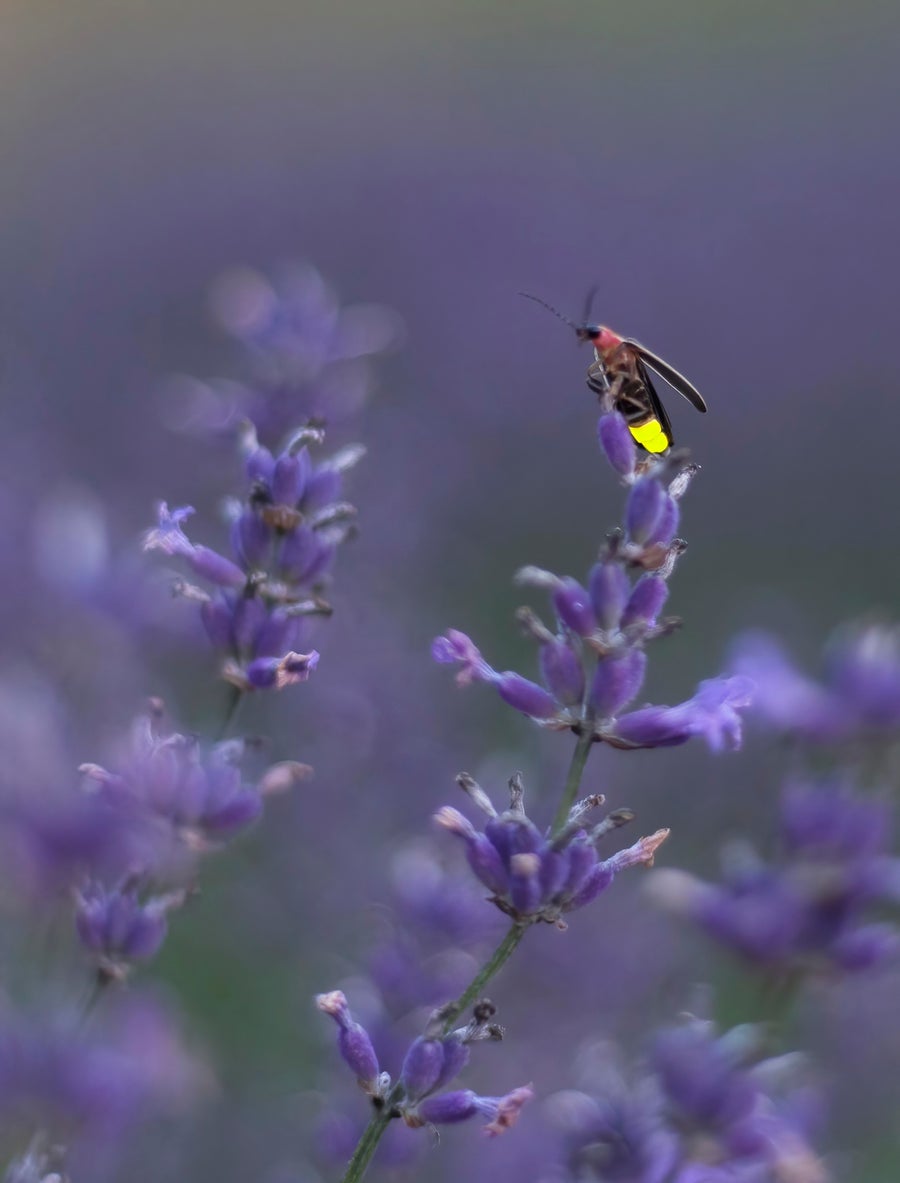
Fireflies are perhaps the most recognized bioluminescent organisms, but the ability to emit light has been documented in hundreds of genera across the tree of life and has evolved multiple times in multiple lineages.
Kim Hadley Photography/iNaturalist ( CC BY-SA 4.0 )
Hunting for the fungal glow
Bioluminescent fungi have long grabbed people’s attention. In the fourth century BCE, Aristotle noted that fungi could be “fiery and glittering” in the dark. A few centuries later, Pliny the Elder , in his encyclopedic Natural History , mentions the “ brilliant light ” emitted by a mushroom that grows on trees. But until recently, no one knew exactly what fungi were using as the fuel or catalyst, or even whether all glowing fungi light up in the same way.
The hunt for fuel and catalyst molecules culminated in 2017 after more than a century of research and a yearslong international race between a scrappy team from the Americas and a well-connected lab in Russia. Yet even before then, scientists had been trying to unravel the mysteries of bioluminescence.
In the 1880s, French physiologist Raphaël Dubois was investigating a click beetle of the genus Pyrophorus , among the brightest of bioluminescent insects. Dubois ground up the glowing parts of the beetle in cold water. They glowed and then faded to nothing. Then he did the same in boiling water: no glow. But when he added the hot mixture to the cold, the mixture glowed. Dubois (who would go on to coin the terms luciferin and luciferase ) realized that the reaction required a catalyst and fuel. Only the cold water contained working catalyst — boiling destroyed it. But both hot and cold extracts contained the fuel, which survived boiling. Adding the hot extract to the cold extract provided fresh fuel to the extract with functioning catalyst — and so it generated light.
Decades later, scientists would conduct this hot/cold experiment with bioluminescent fungi, but the identity of the fuel and the catalyst still eluded them.
Roughly 130 fungus species are bioluminescent, says mycologist Dennis Desjardin , emeritus researcher at San Francisco State University, who has described several of those species. Fungi spend most of their lives as webs of thread-like filaments called mycelia, and the mycelia of the bioluminescent fungi give off light, though it’s often hidden within the decaying wood in which many of them grow. In species that bear mushrooms, the mushrooms may glow too.
In 2005, Desjardin began working with chemist Cassius Stevani of the University of Sao Paulo, Brazil, who was looking into how fungi generated their glow. Stevani, along with then-graduate student Anderson Oliveira , had refined Dubois’ hot/cold experiment, adding various cellular chemicals to grease the reaction. After perfecting the protocol, Stevani wanted to perform the hot/cold experiment using different species of fungi, one species for the cold and another species for the hot. These cross-species experiments showed that the different fungi used the same catalyst and fuel , suggesting that bioluminescence had evolved just once in the fungal lineage, Stevani and Desjardin reported in 2012.
“This was very important,” says Stevani. “It was saying, Oh, if you have a fungus in Russia or in Asia, you can use it to study the mechanism, because it’s the same in all fungi.”
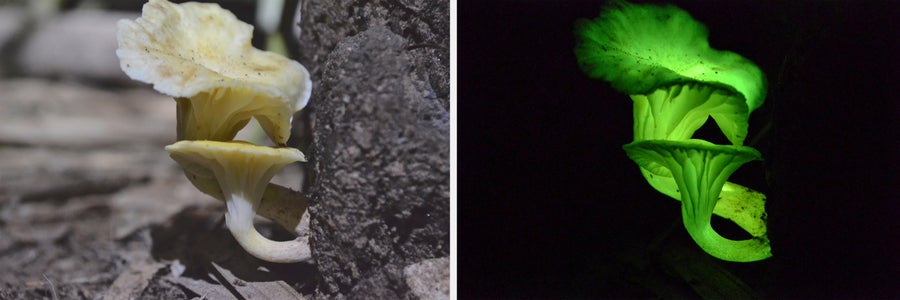
The bioluminescent fungus Neonothopanus gardneri from the state of Piauí in northeast Brazil, where the mushrooms grow on the base of babassu palms. Roughly 130 fungal species are bioluminescent.
Cassius Stevani/ IQ-USP, Brazil
Meanwhile, biochemist Ilia Yampolsky , who now heads a lab at the Russian Academy of Sciences in Moscow, was also hot on the fungal-light trail. Stevani got wind of this development. “I got crazy, of course, because, I was studying this for 15 years,” he says. He wrote to Yampolsky in 2015, suggesting that they collaborate. But the Russians had beaten Stevani to the luciferin punch; their discovery just hadn’t been published yet.
The fungal fuel turned out to be made from an antioxidant called hispidin. Hispidin is found not only in fungi, but also in many plants as well. “The molecule I was searching for, for 15 years — I look out of my window, I see plants that have this molecule,” Stevani says.
Since then, the two teams have collaborated. (“We colluded with the Russians,” Desjardin jokes.) They nailed down details of the biochemical assembly line that leads up to the light-emitting reaction and published the results together in the Proceedings of the National Academy of Sciences in 2018. Stevani got to name the fungal catalyst. He called it luz , the Portuguese word for light.
Out of fungi and into the petunia
A key discovery in the creation of the glowing petunia was the source of the luciferin fuel in the fungi. It’s made from a precursor compound called caffeic acid that is common in fungi and in plants. The fungal assembly line for making light forms a tidy loop — caffeic acid gets converted to hispidin, hispidin gets converted to the fuel, the fuel gives off light and the remaining compound gets converted back into caffeic acid — restarting the loop. Stevani realized that if plants also made that precursor compound, then practically any plant might be engineered to glow. He said as much to Yampolsky. “I said, ‘Man, we have a system that uses caffeic acid. We can transform any plant!’”
Yampolsky replied, “What do you think I am doing?”
Russian synthetic biologist Karen Sarkisyan led the careful work of sorting out the various genes involved in the light-emitting reaction. Then the team stuck those genes — from the bioluminescent fungus Neonothopanus nambi — into a tobacco plant. It worked: The shoots, buds, flowers and even roots — they all glowed . “Plants and fungi, they speak a similar biochemical language,” says Sarkisyan, a cofounder of Light Bio who now runs his own lab at Imperial College London. “And because they speak that similar biochemical language, it was relatively easy to translate the metabolic pathway from the fungus to the plant.”
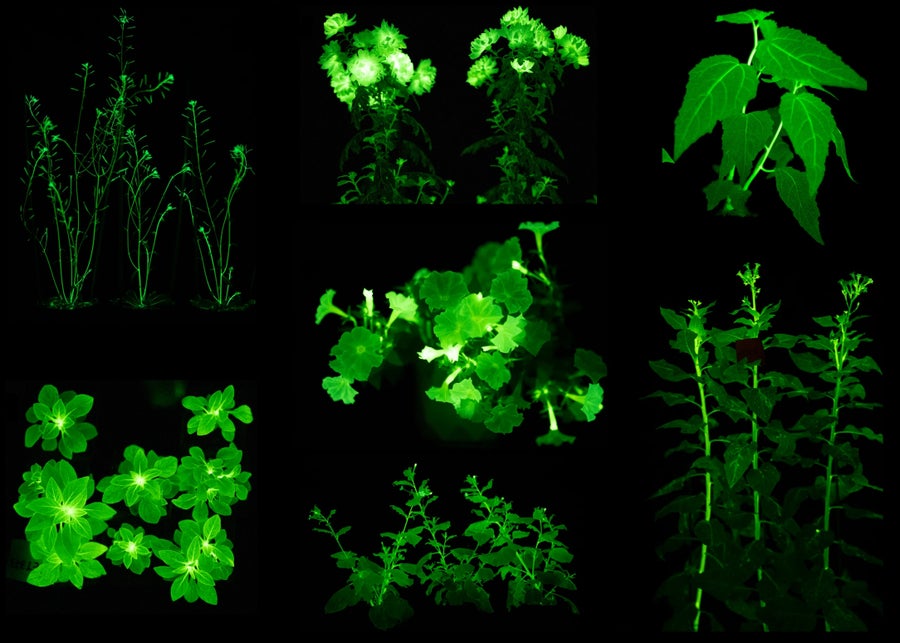
After some clever genetic tinkering, scientists successfully engineered several kinds of plants to glow using genes from fungi: the mouse-ear cress Arabidopsi thaliana ( top left ), a chrysanthemum ( top middle ), poplar ( top right ), petunia ( center and bottom left ), Nicotina benthamiana ( bottom middle ) and tobacco ( bottom right ).
"An improved pathway for autonomous bioluminescence imaging in eukaryotes," by Shakhova, E.S., Karataeva, T.A., Markina, N.M. et al., in Nature Methods , Published online January 22, 2024
With a bit more genetic tinkering, Sarkisyan, Yampolsky and their collaborators managed to coax other plants — chrysanthemum, poplar, Arabidopsis and petunia — into glowing. By September 2023, the US Department of Agriculture had approved Light Bio’s request to make and sell glowing petunias , determining that the plants posed no great risks. Five months later, I placed my order.
Oh, Petunia
My petunia looked like an ordinary white garden petunia when it arrived. It was a bit disheveled; I transplanted it into a new pot and gave it some water and a spot by a sunny window. After a few weeks it perked up. When I brought it into a dark closet, its flowers faintly glowed — dimmer than a candle, but glowing nonetheless.
I had intended to look into whether the petunia could wreak any ecological havoc — what if it interbred with wild species and the glowing genes escaped? Might our outdoor spaces be transformed into (very quiet) botanical raves? But the petunia’s light seemed too dim to interfere with much of anything.
Elsa Youngsteadt , who coauthored an article in the 2023 Annual Review of Ecology, Evolution, and Systematics on how constant light in urban environments may influence pollination, basically agreed with me.
She explained that there aren’t any wild native petunias in the United States, which is the only place where the Firefly petunia is currently available. The ubiquitous common garden petunias are all hybrids, the result of a long history of crossing the white-flowered and moth-pollinated Petunia axillaris with a pigmented, bee-pollinated species . These hybrid petunias already present a crazy mix of signals that might confuse a pollinator, says Youngsteadt, a pollination ecology expert at North Carolina State University. And none of them have proved to be invasive in the United States.
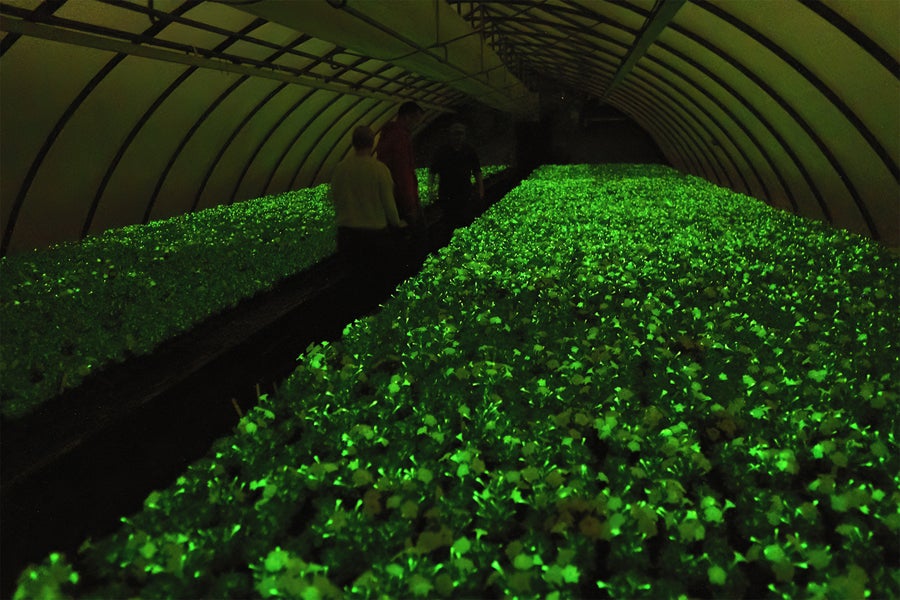
A greenhouse filled with Firefly petunias.
So — the Firefly petunia? “I’m not immediately alarmed by it,” Youngsteadt says. But, she adds, “Why would we put time, money and potential risk into making something glow for fun?”
Why indeed. In fact, the more I thought about it, the more I wondered whether popping the fungal genes into the petunia was just the whimsical icing on a cake. The cake — the real marvel — was all the years of gumshoe detective work that went into figuring out precisely how the fungi got their glow. And that made me look at my petunia with a fondness that surprised me.
This article originally appeared in Knowable Magazine , an independent journalistic endeavor from Annual Reviews. Sign up for the newsletter .

COMMENTS
TL;DR: In a science experiment, the controlled or constant variable is a variable that does not change. For example, in an experiment to test the effect of different lights on plants, other factors that affect plant growth and health, such as soil quality and watering, would need to remain constant.
Khan Academy
More complex experiments can have more than one control group or more than one experimental group. In your plant experiment, you might test a second experimental group using a plant light, rather than a room light. Notice that a control group is different from a controlled variable. The purpose of a controlled variable is to ensure that
Controlled Experiment Definition. A controlled experiment is a scientific test that is directly manipulated by a scientist, in order to test a single variable at a time. The variable being tested is the independent variable, and is adjusted to see the effects on the system being studied. The controlled variables are held constant to minimize or ...
An evaluation experiment will highlight a compound, a technique, a piece of equipment, or an organism, and will include a control and/or other alternatives. Evaluation experiments are common in horticultural and agronomic research, where the purpose of the experiment is to identify, for example, the best cultivar , production method, pest ...
Positive controls help researchers identify problems with an experiment. Negative control group: A negative control group consists of subjects that are not exposed to a treatment. For example, in an experiment looking at the effect of fertilizer on plant growth, the negative control group receives no fertilizer.
A control variable is any factor that is controlled or held constant in an experiment. A control variable is any factor that is controlled or held constant during an experiment. For this reason, it's also known as a controlled variable or a constant variable. ... One light source might be hotter than the other, affecting plant growth. This ...
The experiment should control the amount of water the plants receive and when, what type of soil they are planted in, the type of plant, and as many other different variables as possible. This way, only the amount of light is being changed between trials, and the outcome of the experiment can be directly applied to understanding only this ...
This animation describes the process of conducting a controlled experiment. This is the first video in a two-part series. Watch the second video, "Independen...
An experiment needs to be run simultaneously in which no fertilizer is given to the plant. This would be known as a control experiment . The plants that do not receive the fertilizer are the control group. An experiment must have a control group. In the control group, nothing is changed. It is not subjected to the independent variable.
A control group in a scientific experiment is a group separated from the rest of the experiment, where the independent variable being tested cannot influence the results. This isolates the independent variable's effects on the experiment and can help rule out alternative explanations of the experimental results. Control groups can also be separated into two other types: positive or negative.
Divide the class into groups and have each group perform 1 complete replicate (control and all treatments) of the same experiment. **During the investigation students should plant more seeds for germination to be used in ... • **After students have performed one plant experiment they should be ready for a less teacher directed approach. How ...
References. About the Author. In an experiment, there are multiple kinds of variables: independent, dependent and controlled variables. The independent variable is the one the experimenter changes. The dependent variable is what changes in response to the independent variable. Controlled variables are conditions kept the same.
By. Daniel Nelson. An experimental control is used in scientific experiments to minimize the effect of variables which are not the interest of the study. The control can be an object, population, or any other variable which a scientist would like to "control.". You may have heard of experimental control, but what is it?
Experiment with Plant Growth Science Projects. (26 results) Garden and grow plants in all sorts of ways-- in different light, soils, water, and more. Test how fruits ripen, plant seeds, grow a garden in water, or start with plantlets rather than seed. Learn to measure plant growth accurately. Hydroponics: Gardening Without Soil.
Negative Control. The process of conducting the experiment in the exact same way on a control group except that the independent variables are a placebo that is not expected to produce a result. For example, an experiment on plants where one group of plants are given a fertilizer delivered in a solution and a control group that are given the ...
Published on April 19, 2021 by Pritha Bhandari . Revised on June 22, 2023. In experiments, researchers manipulate independent variables to test their effects on dependent variables. In a controlled experiment, all variables other than the independent variable are controlled or held constant so they don't influence the dependent variable.
The control group in the plant example would be the plant out of the sunlight because the experiment is specifically looking at whether or not plants grow better in the sunlight.
In an experiment, the control is a standard or baseline group not exposed to the experimental treatment or manipulation.It serves as a comparison group to the experimental group, which does receive the treatment or manipulation. The control group helps to account for other variables that might influence the outcome, allowing researchers to attribute differences in results more confidently to ...
The experiment can be carried out in a team. Your task is to examine and estimate the effects of seed type and amount of water on the growth of a particular type of plant. You will have to design the experiment, collect the data, enter the data into SPSS, carry out the statistical analysis, and formulate your conclusions.
Add 1 tablespoon of salt to the 2nd cup (label cup "salt 2"). Add 3 tablespoons of salt to the 3rd cup (label cup "salt 3"). Place each cup in a non-clear cup (no holes) and add ½ cup of water to each and let absorb. Add another ½ cup of water. Place 30 grass seeds in each cup and cover with 1/8" of new soil and moisten new soil.
It's used as a benchmark or a point of comparison against which other test results are measured. Controls are typically used in science experiments, business research, cosmetic testing and medication testing. For example, when a new type of medicine is tested, the group that receives the medication is called the "experimented" group.
It allows you to compare the effect of the fertilizer with respect to the normal growth factor and the extent to which the fertilizer enhanced the growth of the plant. A controlled experiment tries to form a link between the cause and the effect. If we are to study the effect of fertilizers on plant growth, the cause will be the 'fertilizer ...
A previous study by the group of Professor Dodd identified a genetic pathway under the control of the biological clock that operates to protect photosynthesizing plants from cell damage in bright ...
Other signs of a gnat infestation are your plants wilting, losing leaves, and turning yellow. Slow plant growth can be another sign of a gnat problem. Gnat infestations can weaken your plants and make them more susceptible to other pests and diseases. Some common things that attract fungus gnats include:
Campers learned about plant naming and families, harvesting seeds and food, planting depths, and making tea using garden herbs! Sam Stephens, a long-time Trustee of Trent House, helped young people understand the history of indigenous and enslaved people in the time of William Trent. ... New Jersey Agricultural Experiment Station Rutgers, The ...
June 11-12, 2024Seattle, WADay 1: Tuesday, June 11, 2024TimeEvent8:00 - 9:00 AMRegistration & Networking Breakfast9:00 - 9:10 AMOpening Remarks, Meeting Overview and ObjectivesAhmed Diallo, Program Director, ARPA-E9:10 - 9:20 AMDOE Leadership RemarksDerek Passarelli, Principal Deputy Under Secretary for Science & Innovation, DOE9:20 - 9:30 AMUpdate from The Fusion Energy Sciences ...
But this plant was special. This petunia glowed in the dark. My plant was one of 50,000 shipped around the United States in April by the Idaho-based biotech start-up Light Bio. Called the ...
Meanwhile, the new corporate strategy for plant-based meat caused quite a stir in the r/vegan subreddit, with varied opinions. One user took a middle-of-the-road approach, saying, "Small steps ...
The plant, in southern Ukraine, has been under Russian control since March 2022. "Yet again we see an escalation of the nuclear safety and security dangers facing the Zaporizhzhia Nuclear Power ...